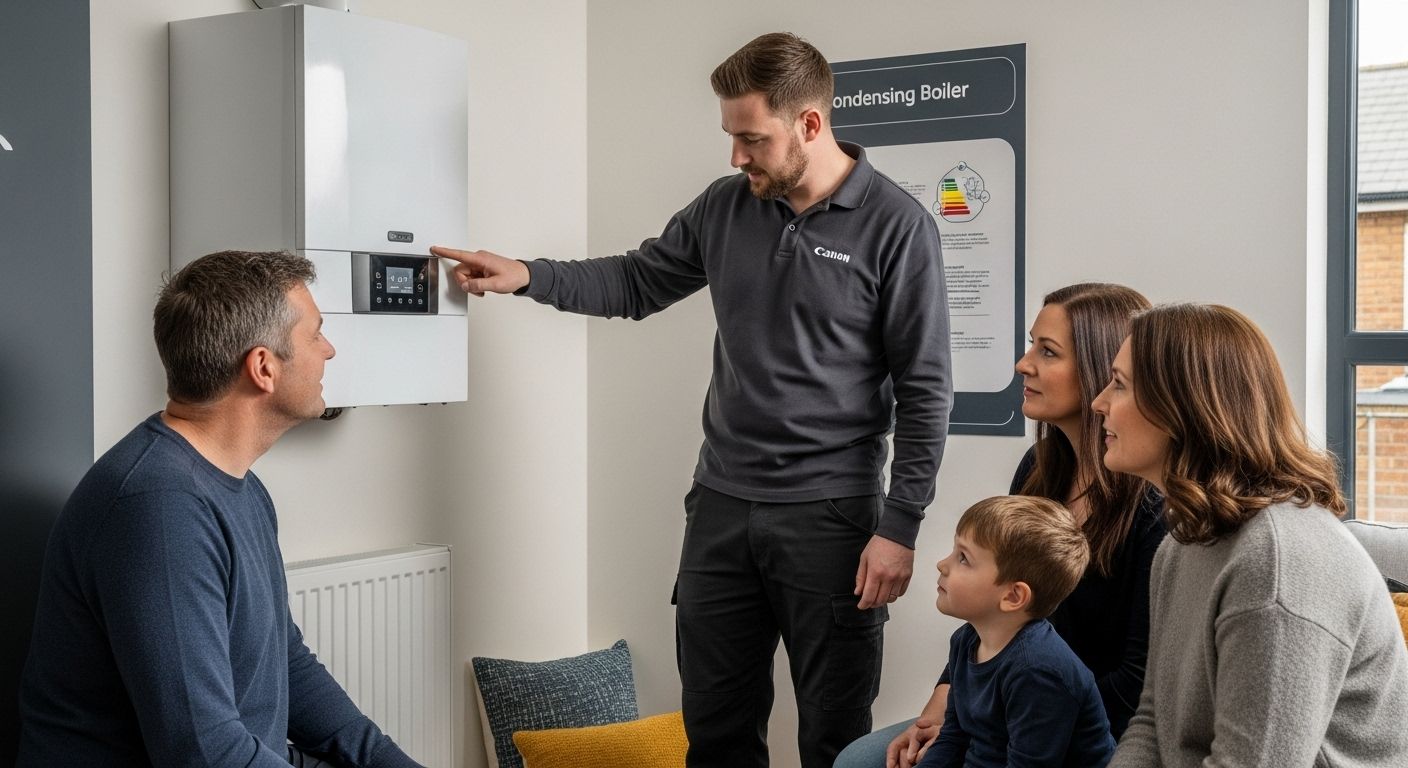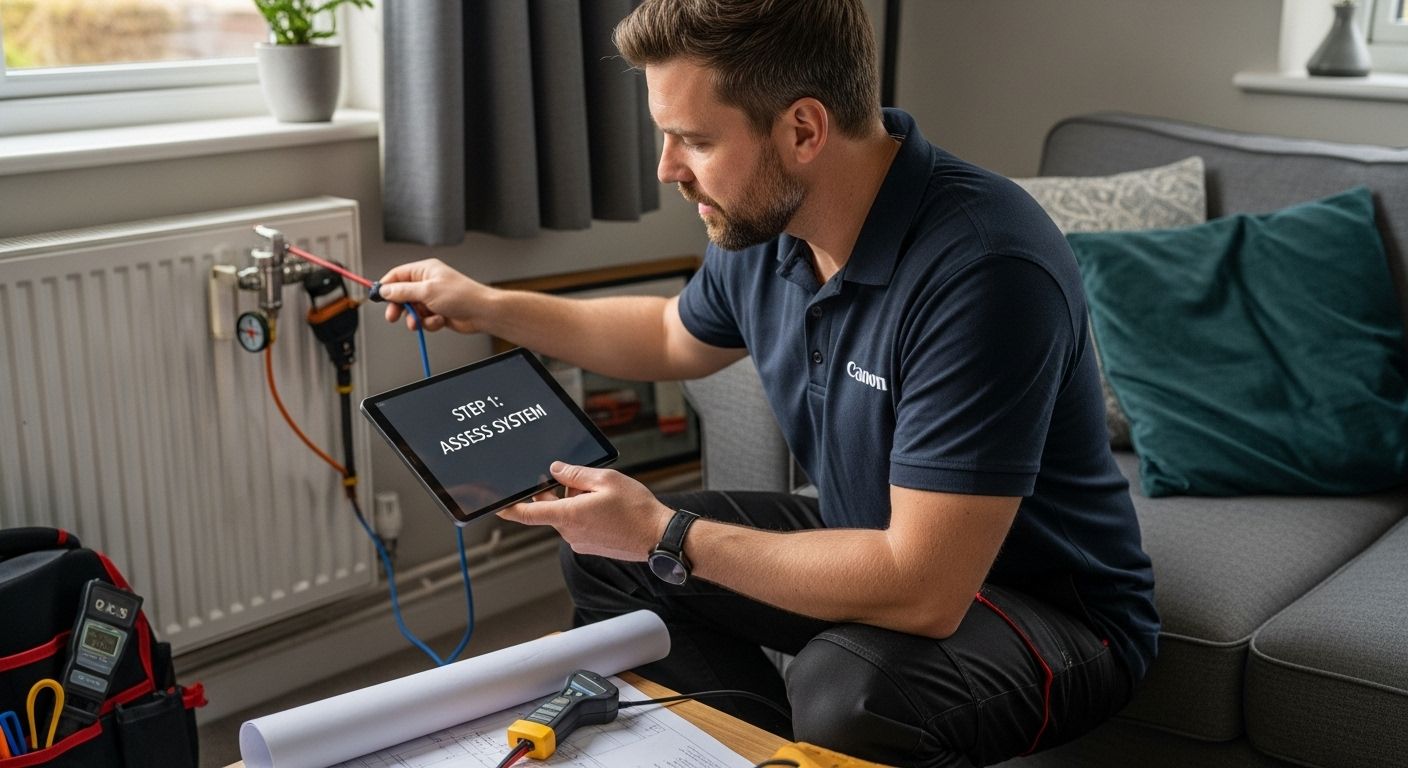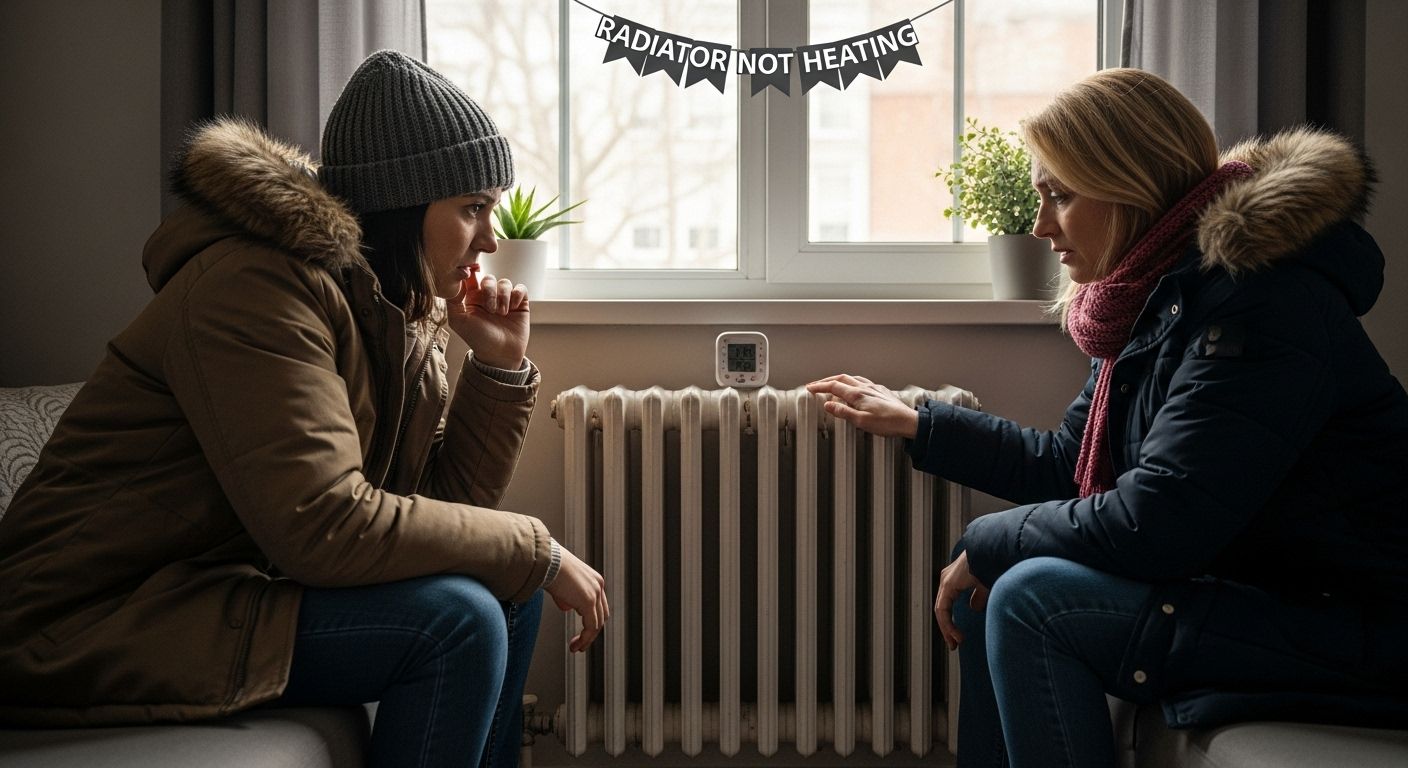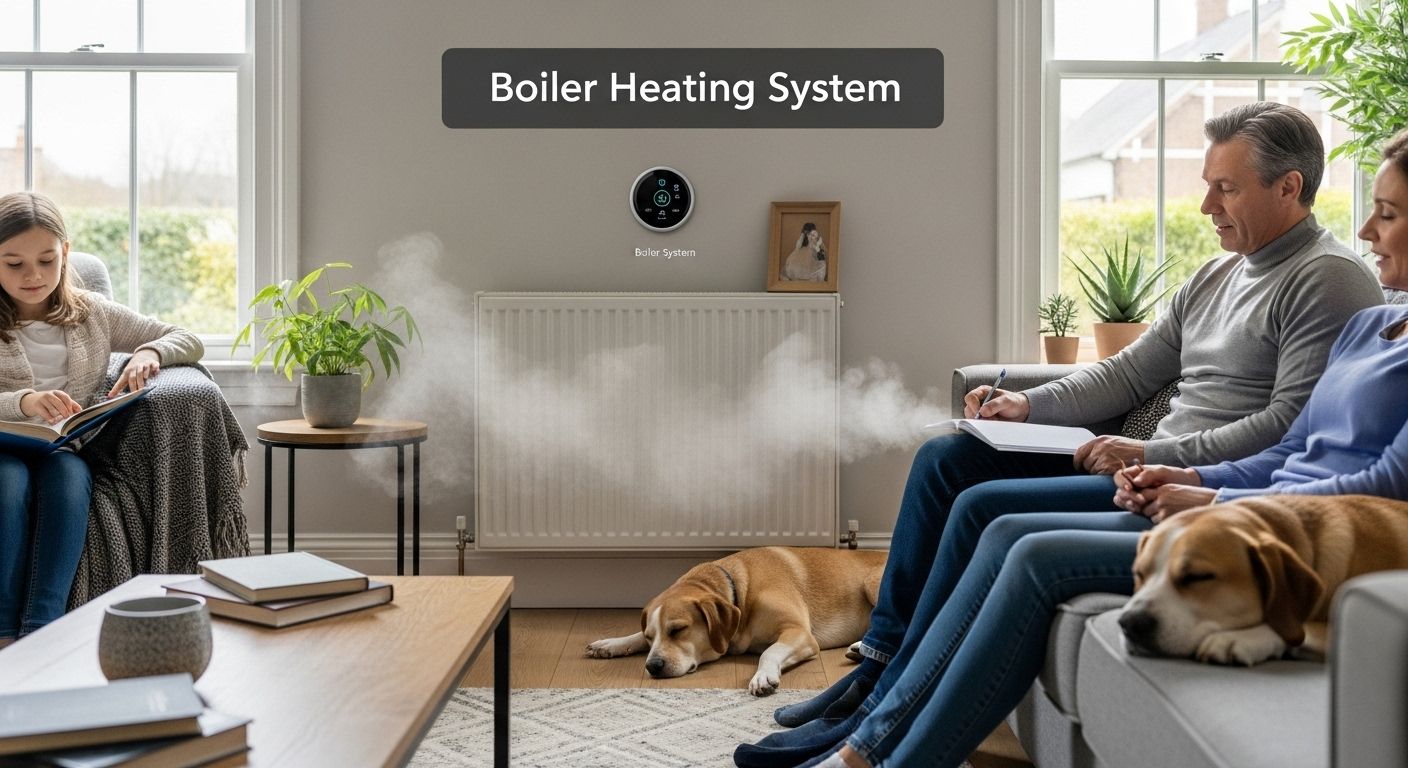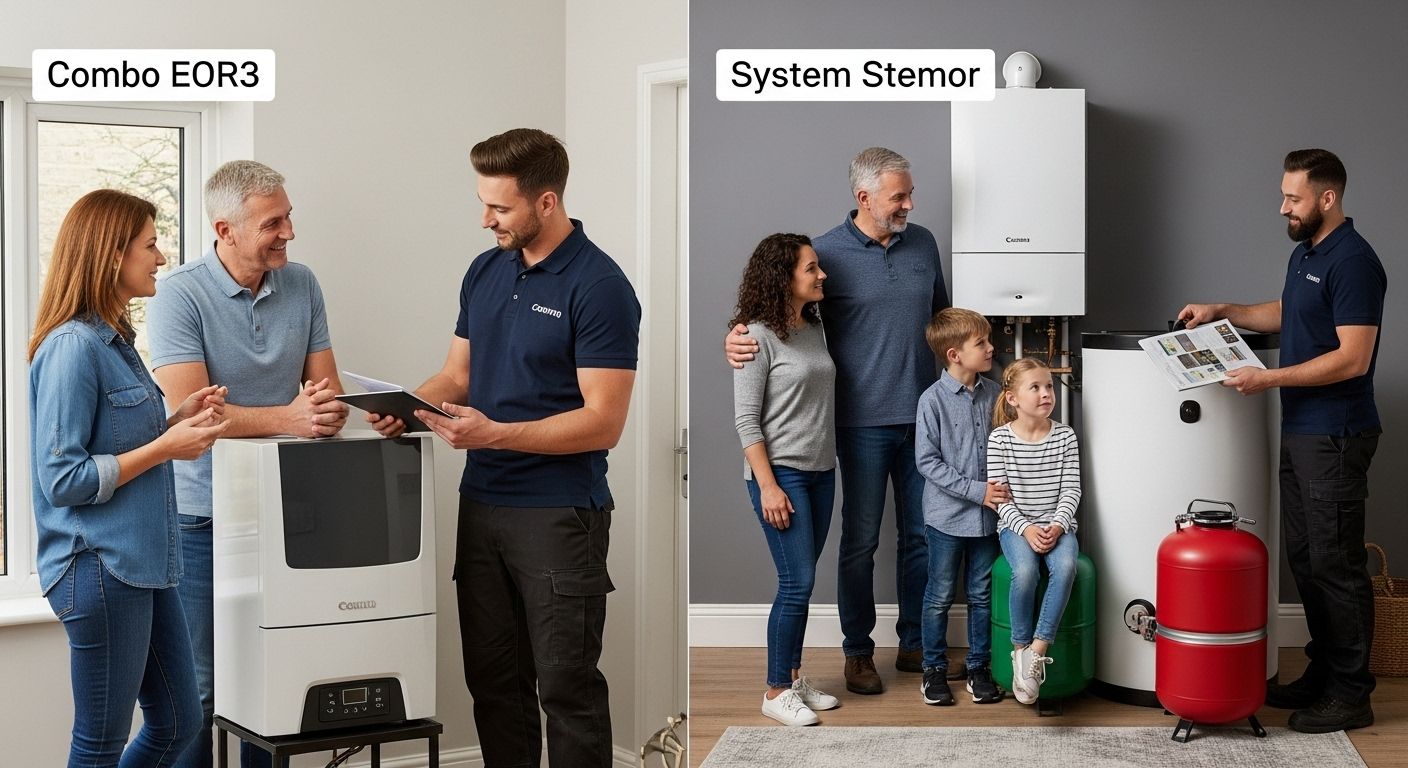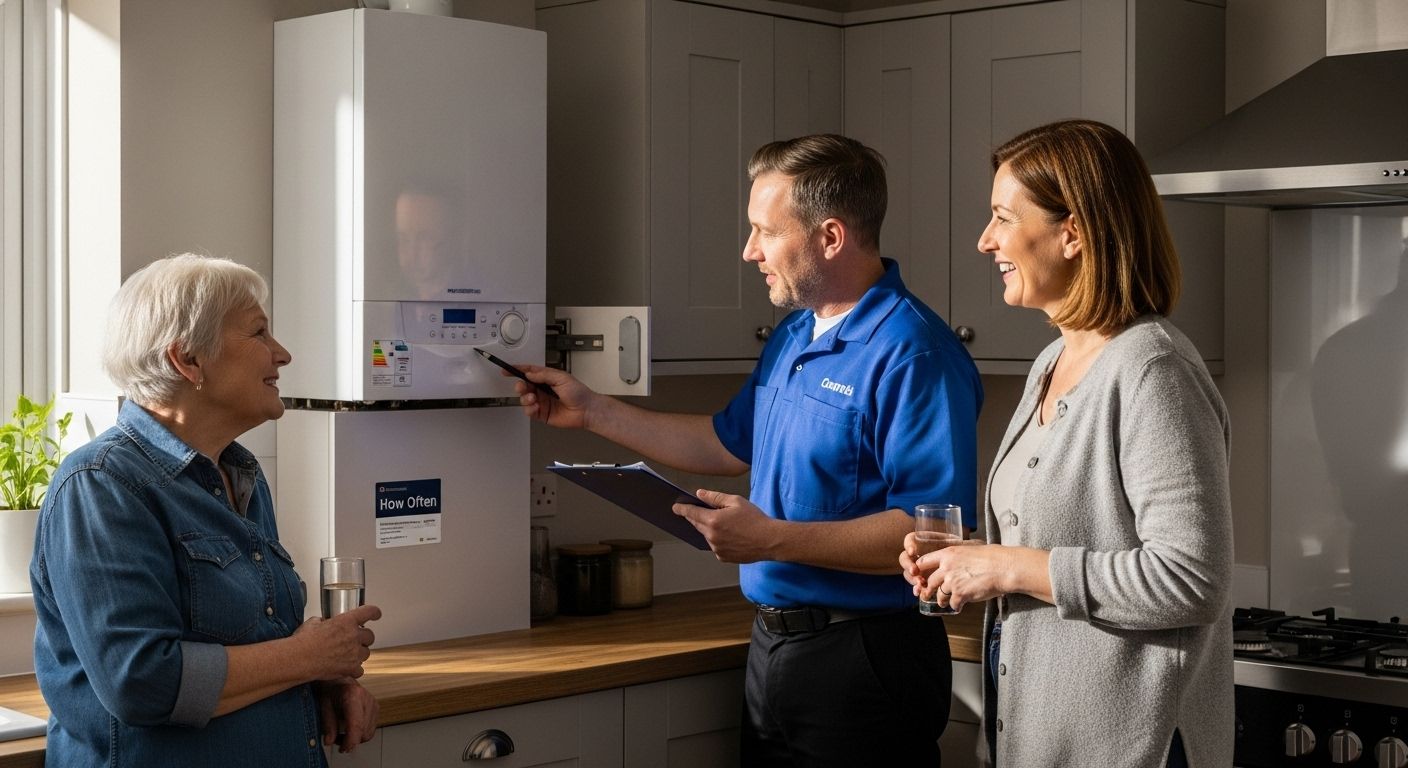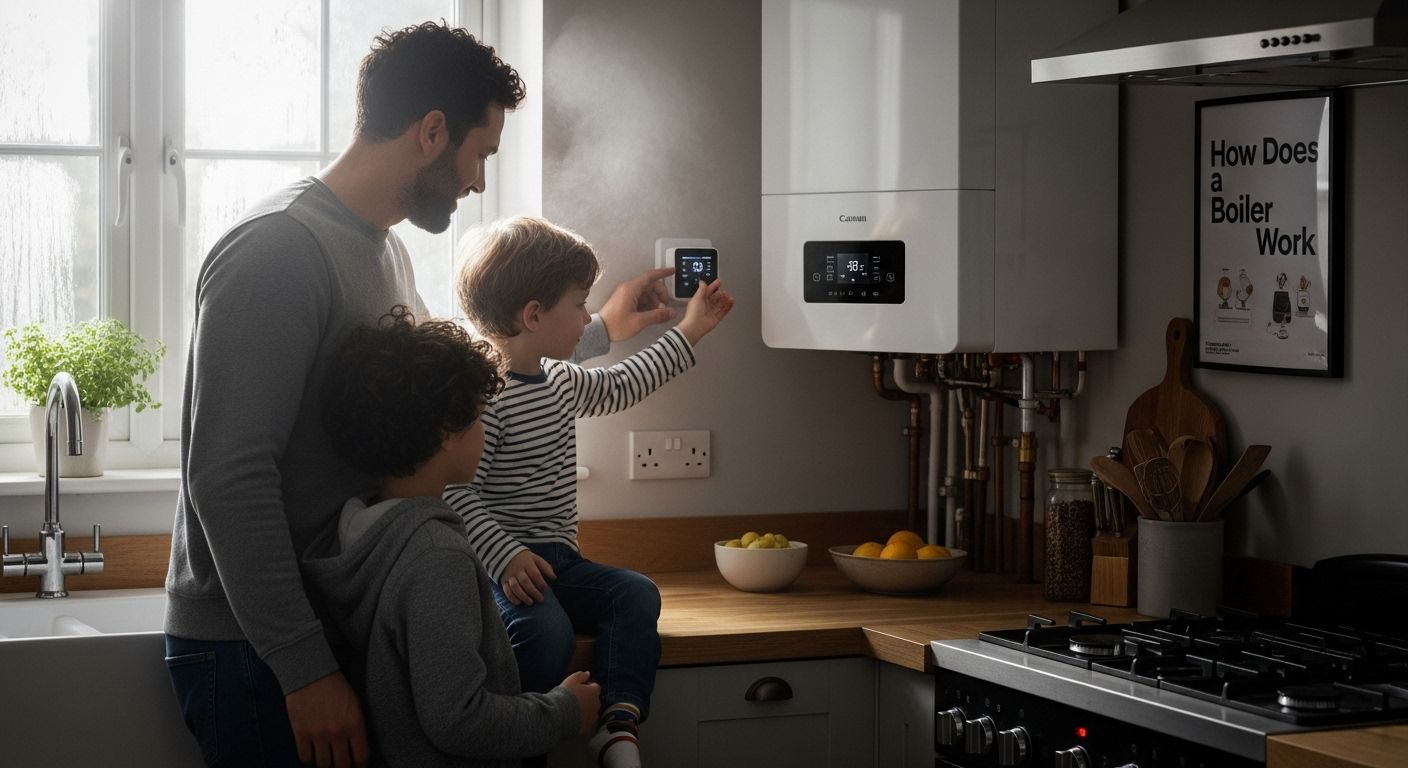What is a Condensing Boiler and Why It Matters
Condensing boilers have quickly become the smart choice for home heating, thanks to their intelligent design that captures otherwise wasted energy. Most people expect a new boiler to give a bit more warmth or use less gas, but the numbers are startling. These systems reach up to 98% efficiency and can cut household bills by as much as 30 percent. What surprises many is that it’s not just about saving money or keeping cosy, it is the hidden science inside that transforms everyday heating into advanced energy recycling for your home.
Table of Contents
- Understanding The Basics Of Condensing Boilers
- The Importance Of Energy Efficiency In Heating
- How Condensing Boilers Transform Heat
- Key Components And Their Functions In Condensing Boilers
- Real-World Benefits Of Using Condensing Boilers
Quick Summary
| Takeaway | Explanation |
|---|---|
| Condensing boilers are highly efficient | They achieve efficiency ratings of up to 98%, significantly outperforming traditional boilers. |
| Reduce energy costs by up to 30% | Homeowners can save substantially on energy bills due to improved fuel conversion efficiency. |
| Lower carbon emissions than traditional systems | Condensing boilers generate about 20% less carbon emissions, aiding environmental sustainability. |
| Advanced components ensure optimal performance | Features like dual heat exchangers and electronic controls enhance efficiency and safety. |
| Long-term investment benefits | Increased property value and eligibility for energy efficiency incentives make condensing boilers a smart financial choice. |
Understanding the Basics of Condensing Boilers
A condensing boiler represents an advanced heating technology designed to maximise energy efficiency and reduce heating costs for homeowners. Unlike traditional boilers, these innovative systems capture and reuse heat that would typically be lost through exhaust gases, making them significantly more efficient in converting fuel into usable heat.
The following table summarises the key differences between condensing boilers and traditional boilers as described in the article, helping readers quickly grasp the main advantages of the condensing technology.
| Feature | Condensing Boiler | Traditional Boiler |
|---|---|---|
| Typical Efficiency | Up to 98% | 70–80% |
| Heat Recovery | Captures and reuses waste heat | Discards exhaust heat |
| Carbon Emissions | About 20% lower | Higher emissions |
| Energy Costs | Can reduce bills by up to 30% | Higher energy bills |
| Advanced Components | Dual heat exchangers, electronic controls | Basic controls, single heat exchanger |
| Environmental Impact | Smaller carbon footprint | Greater environmental impact |
| Initial Investment | Higher, but offset by long-term savings | Lower, but less efficient |
How Condensing Boilers Operate
The core mechanism of a condensing boiler revolves around its sophisticated heat exchange process. While standard boilers simply expel hot exhaust gases, condensing boilers feature a secondary heat exchanger that captures and recycles waste heat. This secondary heat exchanger allows the system to extract additional thermal energy by cooling exhaust gases below their dew point, causing water vapour to condense and release latent heat.
Key operational characteristics include:
- Capturing heat from exhaust gases that would normally be wasted
- Cooling combustion gases to extract maximum thermal energy
- Achieving efficiency ratings up to 95% compared to traditional boilers
Energy Efficiency and Environmental Benefits
According to research from the National Renewable Energy Laboratory, condensing boilers represent a significant advancement in heating technology. These systems can reduce energy consumption by converting up to 90% of fuel into usable heat, compared to traditional boilers that typically operate at 70-80% efficiency.
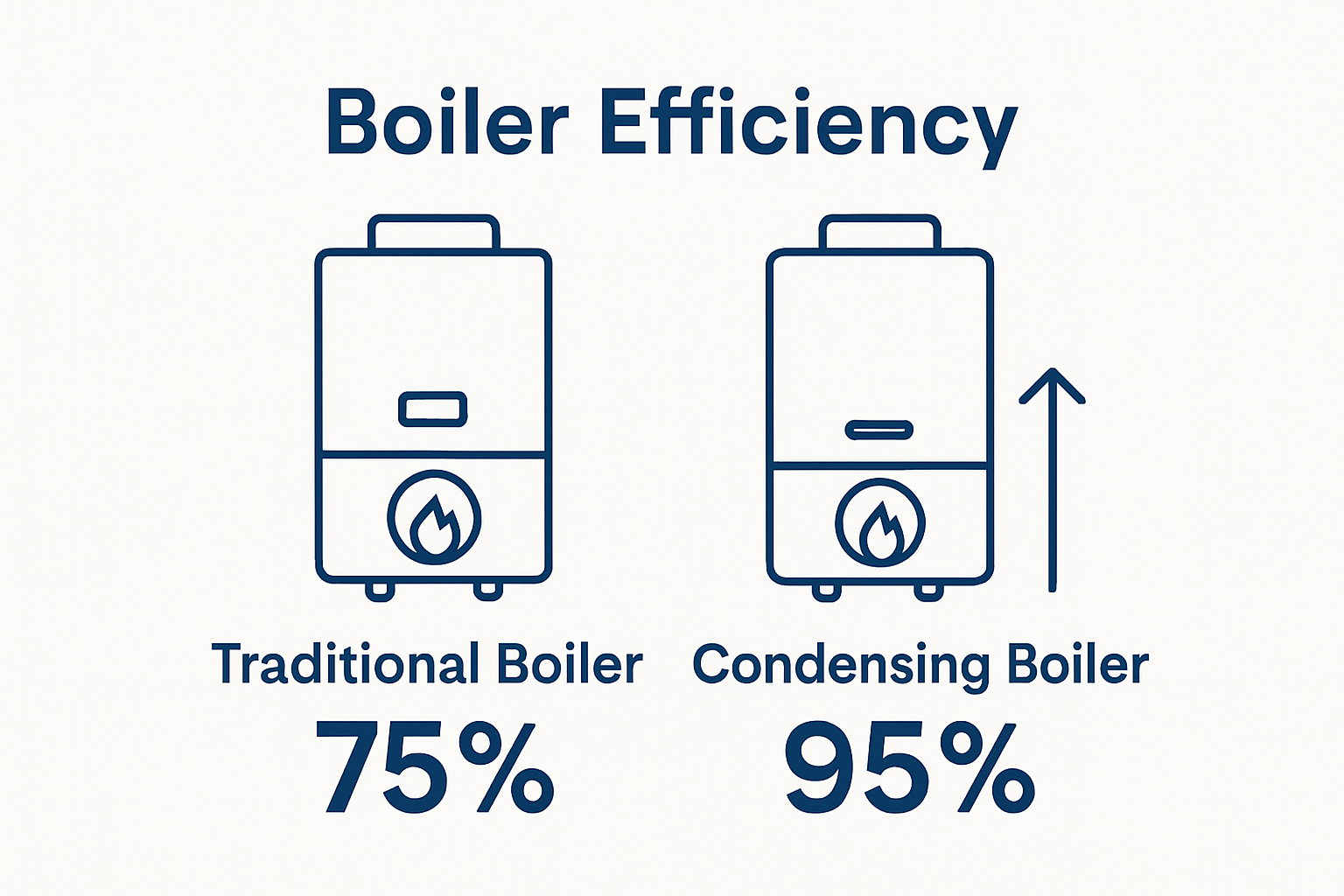
The environmental advantages are substantial. By extracting more heat from each unit of fuel, condensing boilers reduce carbon emissions and contribute to lower household energy consumption. Homeowners can expect not only reduced energy bills but also a smaller carbon footprint when installing these modern heating solutions.
Understanding condensing boilers means recognising them as more than just heating equipment they are sophisticated systems designed to maximise energy utilisation and support sustainable home heating practices.
The Importance of Energy Efficiency in Heating
Energy efficiency in heating is not merely a technical concept but a critical strategy for reducing household expenses and minimising environmental impact. Modern homeowners are increasingly recognising that their heating systems represent more than just comfort they are substantial contributors to both personal financial management and broader ecological sustainability.
Understanding Energy Consumption Patterns
Heating typically accounts for a significant portion of household energy consumption. Research from the Energy Saving Trust indicates that heating can represent up to 55% of annual energy bills in UK households. This substantial percentage underscores the critical importance of selecting and maintaining energy-efficient heating solutions.
Key factors influencing heating energy consumption include:
- Insulation quality of the property
- Age and efficiency of heating systems
- Thermostat settings and usage patterns
- Building design and heat retention capabilities
Economic and Environmental Impact
Improving heating efficiency delivers dual benefits: significant cost savings and reduced carbon emissions. Efficient heating systems can reduce energy consumption by up to 30%, translating into meaningful financial and environmental advantages. Modern technologies like condensing boilers and smart heating solutions represent strategic investments that deliver long-term benefits.
Beyond immediate financial considerations, energy-efficient heating contributes to broader climate action. By minimising unnecessary energy consumption, homeowners directly participate in reducing greenhouse gas emissions and supporting national sustainability goals. Each kilowatt-hour saved represents a tangible contribution to environmental preservation.

How Condensing Boilers Transform Heat
Condensing boilers represent a groundbreaking approach to heat generation, fundamentally changing how thermal energy is captured and utilised within home heating systems. Unlike traditional boilers that lose significant heat through exhaust gases, these advanced systems employ sophisticated heat exchange technologies to maximise energy conversion and efficiency.
The Science of Heat Transformation
According to research from the American Society of Mechanical Engineers, condensing boilers transform heat through a unique two-stage heat exchange process. The primary heat exchanger initially generates heat from fuel combustion, while the secondary heat exchanger captures and recycles waste heat that would typically be expelled through the flue.
Key mechanisms of heat transformation include:
- Cooling exhaust gases below their dew point
- Extracting latent heat from water vapour in exhaust
- Converting previously wasted thermal energy into usable heat
- Reducing overall energy consumption
Thermal Efficiency and Performance
The heat transformation process in condensing boilers is remarkable. By cooling exhaust gases and causing water vapour to condense, these systems can achieve efficiency ratings up to 98%. This means nearly all fuel energy is converted into useful heat for your home. Learn more about our advanced boiler replacement services that can help you upgrade to these high-performance systems.
The condensation process releases additional thermal energy that traditional boilers simply discard. Water vapour in the exhaust contains significant latent heat which, when condensed back into liquid, provides an extra source of thermal energy. This innovative approach represents a quantum leap in heating technology, offering homeowners a more sustainable and cost-effective heating solution.
Key Components and Their Functions in Condensing Boilers
Condensing boilers are sophisticated heating systems composed of multiple intricate components working together to maximise energy efficiency and heat transfer. Understanding these components provides insight into how these advanced systems deliver superior performance compared to traditional heating technologies.
This table outlines the main components of a condensing boiler and their specific functions, providing readers with a clear overview of how each part contributes to the system’s efficiency and safety.
| Component | Function |
|---|---|
| Primary Heat Exchanger | Generates heat from fuel combustion |
| Secondary Heat Exchanger | Captures and recycles waste heat from exhaust gases |
| High-efficiency Transfer Surfaces | Maximises heat exchange and resists corrosion |
| Condensate Drainage System | Removes condensed water safely |
| Temperature and Pressure Sensors | Monitors and regulates system performance |
| Electronic Control System | Optimises efficiency and maintains safe operation |
| Flame Safeguard Controls | Ensures safe combustion and system shutdown if needed |
| Water Level Sensors | Prevents damage from low water levels |
Primary Heat Exchange Architecture
According to research from the Air-Conditioning, Heating, and Refrigeration Institute, the core of a condensing boiler is its dual heat exchanger system. The primary heat exchanger handles initial fuel combustion and heat generation, while the secondary heat exchanger captures and recycles heat from exhaust gases that would traditionally be lost.
Critical components within this architecture include:
- High-efficiency heat transfer surfaces
- Advanced metallic alloys resistant to corrosion
- Precision-engineered condensate drainage systems
- Temperature and pressure monitoring sensors
Control Systems and Safety Mechanisms
Modern condensing boilers integrate sophisticated electronic control systems that monitor and optimise performance. Flame safeguard controls and water level sensors ensure safe and efficient operation by continuously regulating temperature, pressure, and fuel flow. Our comprehensive boiler replacement services can help you upgrade to systems with these advanced safety features.
These intelligent control systems protect against potential issues like overheating, pressure build-up, and inefficient combustion. By continuously adjusting operational parameters, they ensure optimal energy conversion and extend the overall lifespan of the heating system.
Real-World Benefits of Using Condensing Boilers
Condensing boilers represent more than technological innovation they deliver tangible, measurable advantages for homeowners seeking efficient and sustainable heating solutions. By transforming how thermal energy is captured and utilised, these advanced systems provide significant economic and environmental benefits across residential settings.
Financial Advantages
Research from the Energy Saving Trust demonstrates that condensing boilers can reduce household energy bills by up to 30%. The substantial financial savings stem from their exceptional energy conversion efficiency, which means homeowners spend less on fuel while maintaining optimal home comfort. These savings accumulate significantly over the boiler’s operational lifespan, making the initial investment remarkably cost-effective.
Key financial benefits include:
- Reduced monthly energy expenditure
- Lower long-term maintenance costs
- Potential eligibility for energy efficiency incentives
- Increased property value through modern heating infrastructure
Environmental and Performance Impact
Beyond financial considerations, condensing boilers deliver substantial environmental benefits. By maximising heat recovery and minimising energy waste, these systems significantly reduce carbon emissions. Typical condensing boilers generate approximately 20% fewer carbon emissions compared to traditional heating systems, contributing meaningfully to national and global sustainability objectives. Learn more about our comprehensive heating solutions that can help you transition to more environmentally responsible home heating.
Moreover, condensing boilers operate with remarkable consistency, providing stable and uniform heating that enhances overall home comfort. Their advanced design allows for precise temperature control, ensuring optimal thermal management while consuming minimal energy.
Upgrade to a Condensing Boiler Solution Built for You
Are you concerned about rising energy bills and the impact of outdated heating systems on your comfort and the environment? This article outlined how choosing a condensing boiler can transform your energy efficiency, lower carbon emissions, and make your home cosier. Yet, making the leap can feel overwhelming if you are unsure where to find trusted local support, or worry about reliability and compliance.
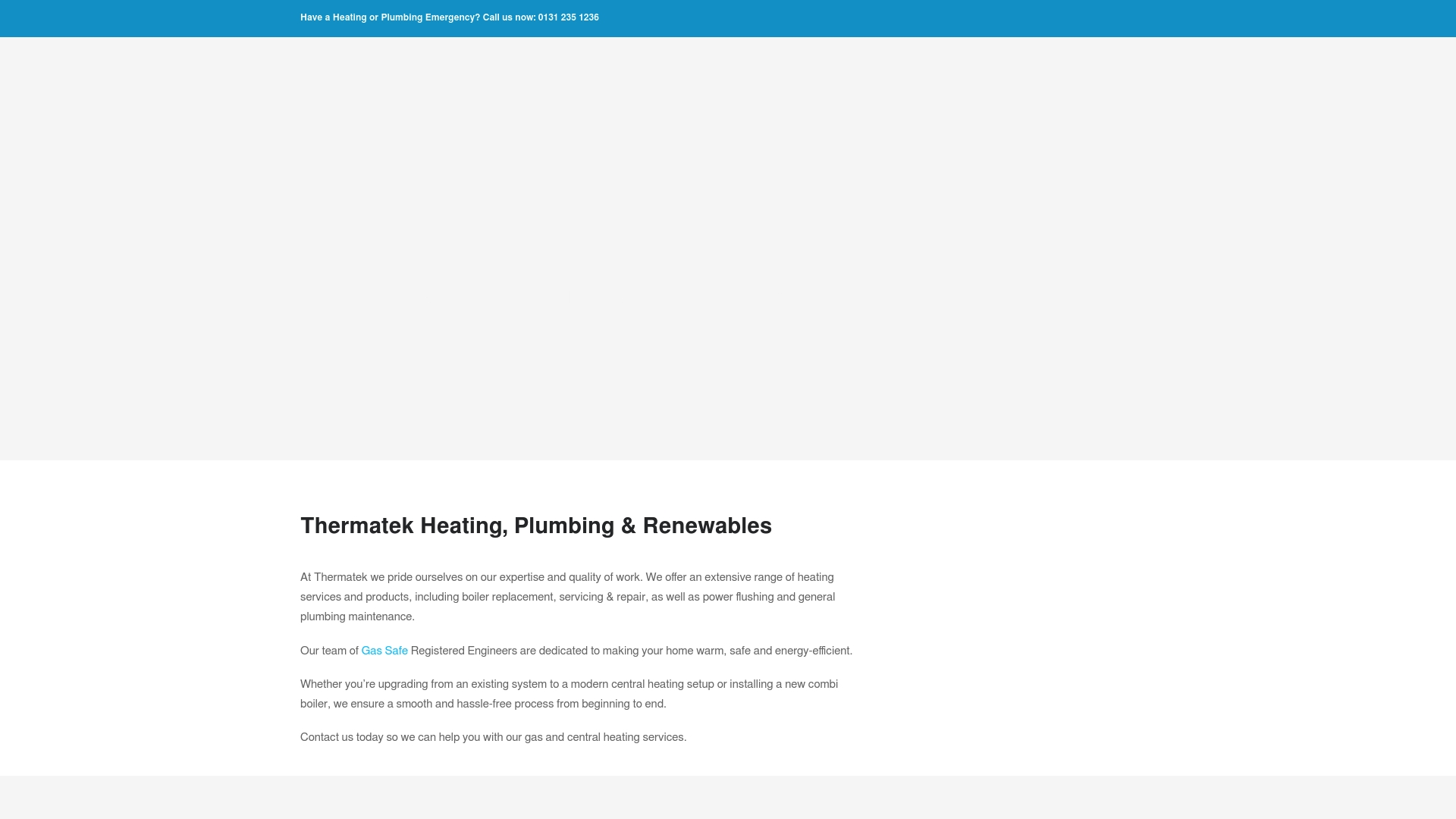
At Thermatek Heating, our Gas Safe Registered engineers specialise in bespoke boiler replacement services that align with the latest technology discussed in this guide. We put your safety and long-term savings first with efficient installations, honest advice, and ongoing support right here in Edinburgh and Midlothian. Do not let another winter catch you off guard. Visit our main site to arrange a free quote and take the stress out of your upgrade today.
Frequently Asked Questions
What is a condensing boiler?
A condensing boiler is an advanced heating system that captures and reuses heat from exhaust gases, achieving energy efficiency ratings of up to 98%. This technology allows for more effective conversion of fuel into usable heat.
How does a condensing boiler work?
Condensing boilers operate by using a two-stage heat exchange process. The first heat exchanger generates heat from fuel combustion, while the secondary heat exchanger recycles waste heat from exhaust gases, maximizing thermal energy capture and reducing energy loss.
What are the benefits of using a condensing boiler?
Condensing boilers offer significant advantages, including up to 30% reduction in energy bills, lower carbon emissions, and enhanced home comfort through more stable and efficient heating performance.
Why is energy efficiency important in heating systems?
Energy efficiency in heating systems not only reduces household energy costs but also contributes to environmental sustainability by minimising carbon emissions. With heating accounting for a large portion of energy bills, choosing an efficient system like a condensing boiler is financially and environmentally beneficial.
Recommended
- New Boiler Installation & Replacement In Edinburgh
- Air Source Heat Pump Installation In Edinburgh
- Annual Boiler Servicing In Edinburgh
- Central Heating Power Flushing In Edinburgh
Essential Air Source Heat Pump Installation Guide
Preparing your home for an air source heat pump is not just about picking the right equipment, it demands a close look at what you already have. Many older properties with traditional systems discover that substantial upgrades are needed before installation even begins. Yet what surprises most homeowners is that even good equipment will underperform if your insulation or electrics are not up to scratch. The secret to efficient heating is often hidden in the basics, where a single overlooked detail can cut system efficiency by up to 30%.
Table of Contents
- Step 1: Assess Your Current Heating System
- Step 2: Choose The Right Air Source Heat Pump
- Step 3: Prepare The Installation Site
- Step 4: Install Indoor And Outdoor Units
- Step 5: Connect Electrical And Plumbing Systems
- Step 6: Test The System And Ensure Proper Functionality
Quick Summary
| Key Point | Explanation |
|---|---|
| 1. Conduct a comprehensive heating system assessment | Evaluate your existing heating setup to ensure it’s compatible with a new heat pump installation. Insulation and electrical capacity are critical factors. |
| 2. Select the right size and model of heat pump | Choose an air source heat pump that matches your property’s heating requirements and climate for optimal performance. Consult a professional for accurate calculations. |
| 3. Prepare the site for installation | Ensure the installation area is clear with proper ventilation and a sturdy foundation for both indoor and outdoor units to prevent future issues. |
| 4. Ensure electrical and plumbing connections are secure | Connect the heat pump’s electrical and plumbing systems professionally to avoid leaks and ensure safety; proper installation is vital for system efficiency. |
| 5. Test the system thoroughly after installation | Conduct comprehensive tests to verify performance and efficiency; ensuring all components function correctly is essential for reliable heating. |
Step 1: Assess Your Current Heating System
Before embarking on your air source heat pump installation, a comprehensive assessment of your existing heating system is crucial. This initial evaluation will determine your property’s readiness and highlight potential modifications needed for optimal heat pump performance.
Start by conducting a thorough examination of your current heating infrastructure. Look closely at your existing radiators, pipework, and central heating system. Older properties with traditional heating setups might require substantial upgrades to accommodate an air source heat pump effectively. Pay special attention to your home’s insulation levels, as heat pumps operate most efficiently in well-sealed environments with minimal heat loss.
Your assessment should include a detailed energy performance audit. Measure and record your property’s current heat loss characteristics by checking wall, roof, and floor insulation standards. Poorly insulated homes will struggle to maintain comfortable temperatures with heat pump technology, potentially reducing system efficiency by up to 30%. Professional energy assessors can provide precise measurements and recommend specific improvements.
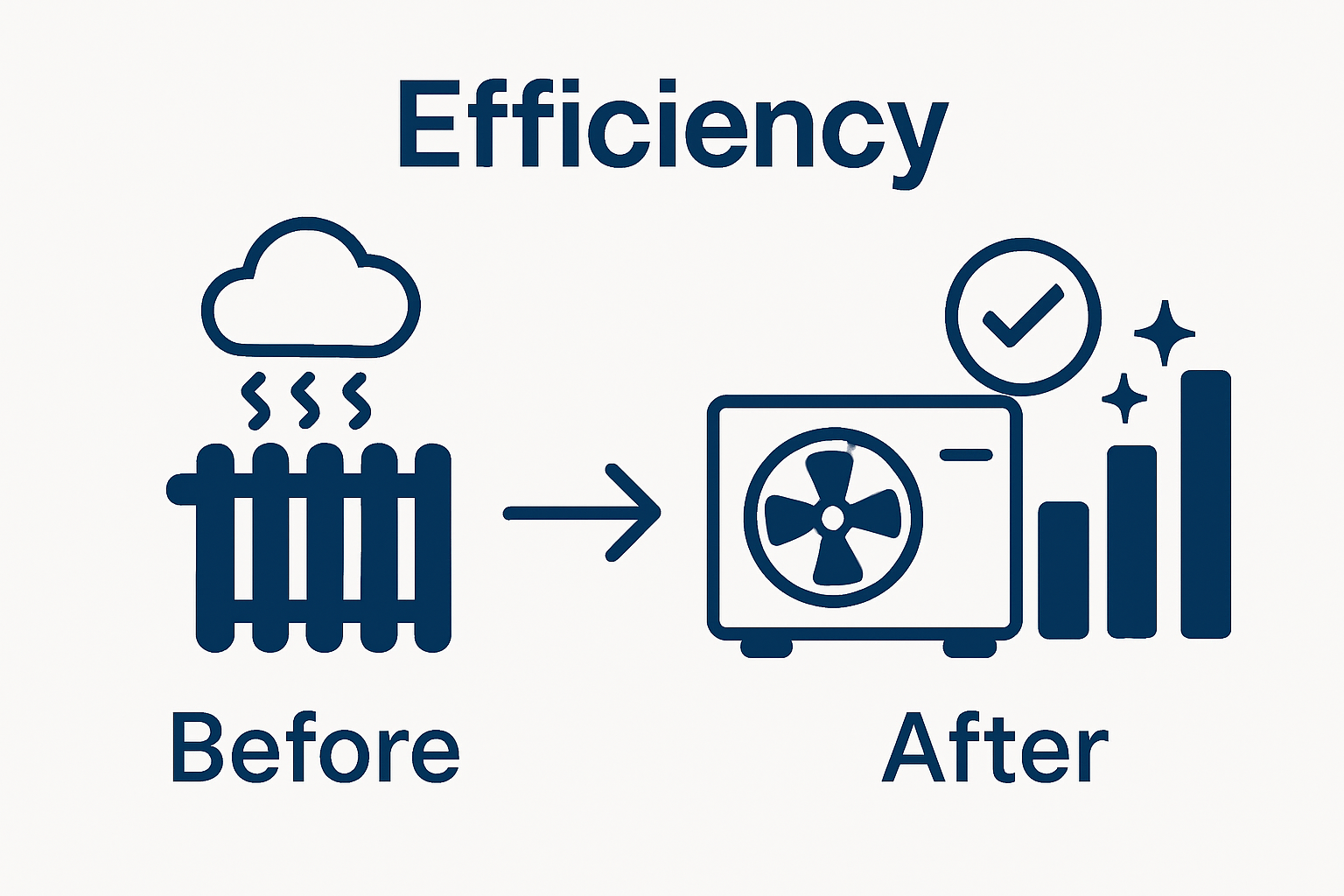
Electrical infrastructure represents another critical evaluation point. Air source heat pumps demand significant electrical capacity, so inspect your property’s main electrical panel and wiring. Confirm that your current electrical system can support the new heat pump’s power requirements without overloading circuits. Learn more about heating system compatibility with our expert installation guidelines.
Key verification criteria for successful system assessment include:
- Confirmed adequate insulation levels
- Verified electrical system capacity
- Assessed radiator and pipework compatibility
- Measured current heating system performance
Consult a qualified heating engineer who can provide a professional evaluation and recommend specific modifications. Their expertise will help you understand whether your property is an ideal candidate for an air source heat pump installation and what preparatory work might be necessary.
A meticulous initial assessment sets the foundation for a successful heat pump implementation, ensuring optimal performance, energy efficiency, and long-term comfort in your home.
Below is a checklist table summarising key verification criteria for the initial system assessment, helping you confirm property suitability for a heat pump installation.
| Assessment Area | What to Check | Why It Matters |
|---|---|---|
| Insulation Levels | Walls, roof, and floors are well-insulated | Reduces heat loss, improves efficiency |
| Electrical System Capacity | Main panel and wiring can support heat pump | Prevents overload, ensures safe operation |
| Radiator & Pipework Compatibility | Existing infrastructure suitable for heat pumps | Avoids need for major upgrades |
| Heating System Performance | Current setup meets basic heating needs | Identifies necessary modifications |
Step 2: Choose the Right Air Source Heat Pump
Selecting the appropriate air source heat pump represents a critical decision that directly impacts your home’s energy efficiency, comfort, and long-term heating performance. This step requires careful consideration of multiple factors to ensure you invest in a system perfectly tailored to your specific property requirements.
Property size and heat requirements form the fundamental starting point for your selection. Heat pumps are not one-size-fits-all solutions. Carefully measure your total floor area and calculate the heating demand. Professional heating engineers use specialized calculations to determine the precise heat output needed, considering factors like room dimensions, insulation quality, window sizes, and local climate conditions. An undersized unit will struggle to maintain comfortable temperatures, while an oversized system wastes energy and increases operational costs.
Consider the climate performance characteristics of different heat pump models. Modern air source heat pumps come with varying efficiency ratings that indicate their performance across different temperature ranges. Look specifically for cold climate heat pump models if you live in regions experiencing significant temperature fluctuations. These units maintain high efficiency even when external temperatures drop, providing reliable heating during winter months.
Electrical compatibility represents another crucial selection criterion. Examine your property’s electrical infrastructure and confirm it can support the heat pump’s power requirements. Some advanced models demand three-phase electrical connections, which might necessitate additional electrical system upgrades. Explore our comprehensive heat pump installation guidance for detailed technical insights.
Key verification criteria for selecting the right air source heat pump include:
- Matched heating capacity to property size
- Appropriate climate performance rating
- Confirmed electrical system compatibility
- Energy efficiency certifications
- Manufacturer warranty coverage
Consult with professional heating engineers who can provide personalized recommendations based on a thorough assessment of your specific property characteristics. Their expertise ensures you select a heat pump system that delivers optimal performance, energy efficiency, and long-term reliability.
Step 3: Prepare the Installation Site
Preparing the installation site is a critical phase that sets the foundation for a successful air source heat pump implementation. This step involves creating an optimal environment for both the indoor and outdoor components of your heating system, ensuring maximum efficiency and longevity.
Outdoor unit placement requires meticulous planning and consideration. Select a location that provides sufficient clearance from walls, vegetation, and potential obstructions. The area should offer unimpeded airflow while protecting the unit from direct wind exposure and excessive debris accumulation. Typically, you’ll want a minimum of 30 centimetres of clear space around the unit, with particular attention to maintaining proper ventilation and accessibility for future maintenance.
Ground preparation becomes paramount for outdoor unit stability. Create a level, sturdy mounting surface using a concrete pad or robust mounting brackets. Ensure the foundation can withstand local weather conditions and provides adequate drainage to prevent water accumulation. If installing on an existing surface, verify its structural integrity and load-bearing capacity. Some installations might require professional ground levelling or specialized mounting solutions to guarantee optimal unit performance.
Indoor preparation involves equally important considerations. Assess your property’s interior layout to determine the most suitable location for the indoor heat pump unit and associated pipework. Check our expert installation recommendations for precise positioning guidelines. Potential mounting locations should offer unrestricted air circulation, proximity to electrical connections, and minimal interference with existing interior structures.
Key verification criteria for site preparation include:
- Clear outdoor unit placement with proper ventilation
- Level and stable mounting surface
- Adequate electrical connection proximity
- Minimal obstructions to airflow
- Accessible location for future maintenance
Consult a professional heating engineer who can conduct a comprehensive site assessment. Their expertise ensures your installation site meets all technical requirements, potentially preventing costly modifications or performance issues down the line. Thorough site preparation transforms a standard installation into an optimized heating solution tailored to your specific property characteristics.
Step 4: Install Indoor and Outdoor Units
Installing the indoor and outdoor units of an air source heat pump requires precision, technical expertise, and careful attention to detail. This critical step transforms your preparation work into a functional heating system that will serve your home for years to come.
The outdoor unit installation demands absolute precision in positioning and mounting. Begin by securing the mounting bracket to the prepared surface, ensuring it remains perfectly level and capable of supporting the unit’s full weight. Use heavy-duty anchor bolts that can withstand local weather conditions and potential environmental stress. Position the unit to maintain recommended clearance from walls and potential obstructions, allowing optimal airflow and minimizing potential operational interference.
Indoor unit placement requires equally meticulous consideration. Select a location that provides unobstructed air circulation and convenient access for future maintenance. Wall-mounted units should be installed at an appropriate height, typically 2.3 to 2.5 metres above floor level, with clear space around the unit to ensure efficient air distribution. Proper mounting involves using robust wall brackets and ensuring perfect horizontal alignment to prevent condensation issues and maintain optimal system performance.
Connecting the indoor and outdoor units represents a complex technical process involving refrigerant line installation, electrical connections, and precise system calibration. Explore our professional installation guidelines for comprehensive insights into this intricate process. Specialized tools and expertise are required to create secure, leak-free connections between components, including proper insulation of refrigerant lines and precise routing to minimize potential energy losses.
Key verification criteria for unit installation include:
- Perfectly level outdoor unit mounting
- Secure wall brackets for indoor unit
- Correct refrigerant line routing
- Proper electrical connection
- Unobstructed airflow around both units
- Precise system alignment
Professional installation is strongly recommended, as improper setup can significantly compromise the heat pump’s efficiency, performance, and long-term reliability. Certified heating engineers possess the technical skills and specialized equipment necessary to ensure a flawless installation that maximizes your system’s potential and protects your investment.
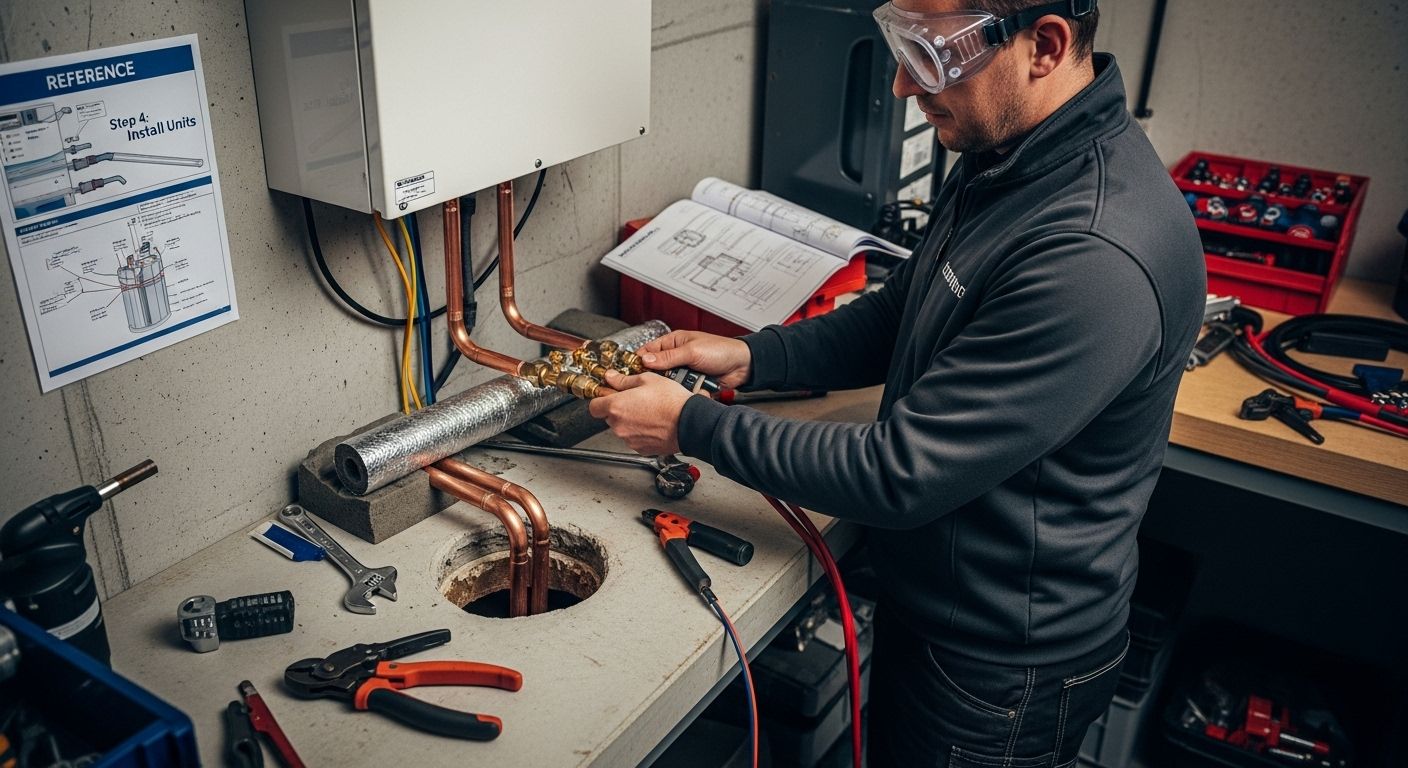
Step 5: Connect Electrical and Plumbing Systems
Connecting the electrical and plumbing systems represents a critical phase in air source heat pump installation that demands precision, technical expertise, and strict adherence to safety protocols. This complex process bridges the gap between your carefully selected equipment and a fully functional heating system.
Electrical connection requires meticulous planning and professional-grade expertise. Begin by confirming that your property’s electrical infrastructure can support the heat pump’s power requirements. This typically involves a comprehensive assessment of your main electrical panel, ensuring sufficient amperage and appropriate circuit protection. Dedicated circuits are essential, as air source heat pumps draw substantial electrical current during operation. Professional electricians will install specialized breakers, verify proper grounding, and ensure all connections meet current building and electrical safety standards.
Plumbing connections demand equally careful consideration. The heat pump’s refrigerant lines and condensate drainage system must be installed with absolute precision to prevent potential leaks or performance issues. Proper insulation of refrigerant lines is crucial to maintain system efficiency and prevent energy loss. Pay special attention to line routing, ensuring minimal bends and maintaining manufacturer-recommended pipe lengths. Explore our detailed installation guidelines for comprehensive insights into technical connection requirements.
Conducting a thorough system pressure test becomes paramount at this stage. Professionally trained technicians will use specialized equipment to verify the integrity of all connections, checking for potential refrigerant leaks and ensuring optimal system pressure. This diagnostic process helps identify and resolve any potential issues before final commissioning.
Key verification criteria for electrical and plumbing connections include:
- Confirmed electrical panel capacity
- Dedicated circuit installation
- Proper grounding and circuit protection
- Leak-free refrigerant line connections
- Correct condensate drainage setup
- Successful pressure and integrity testing
While the temptation might exist to attempt a DIY installation, the complexity of electrical and plumbing connections strongly recommends professional intervention. Certified heating engineers possess the technical skills, specialized tools, and regulatory knowledge necessary to ensure a safe, efficient, and compliant heat pump installation that protects both your investment and your property.
Step 6: Test the System and Ensure Proper Functionality
Testing your newly installed air source heat pump is a critical final step that transforms your technical installation into a reliable, efficient heating system. This comprehensive evaluation ensures every component operates precisely as designed, protecting your investment and guaranteeing optimal performance.
Initial system startup requires methodical and careful approach. Begin by powering the system and observing its first operational cycle carefully. Listen for unusual sounds, monitor airflow from indoor units, and track temperature changes. Professional technicians will conduct a series of diagnostic tests to verify refrigerant charge, electrical connections, and overall system responsiveness. Pay close attention to how quickly the system reaches desired temperatures and the consistency of heat distribution throughout your property.
Performance verification involves multiple diagnostic procedures that go beyond simple operational checks. Technicians will measure system efficiency by comparing actual performance against manufacturer specifications. This includes assessing refrigerant pressures, checking electrical consumption, and evaluating heat output across different operational modes. Temperature differentials and system response times provide crucial insights into the heat pump’s functional integrity. Any variations from expected performance parameters might indicate installation issues requiring immediate adjustment.
Explore our comprehensive system testing guidelines for deeper understanding of technical verification processes. The goal is not just confirming basic functionality but ensuring your heat pump delivers maximum energy efficiency and consistent comfort.
Key verification criteria for system testing include:
- Consistent temperature achievement
- Quiet and smooth operational sounds
- Accurate refrigerant pressure readings
- Proper electrical consumption
- Balanced airflow across all zones
- No error codes or warning indicators
While comprehensive testing might seem complex, it represents the final quality assurance step that transforms your technical installation into a reliable heating solution. Professional engineers will provide detailed performance reports, documenting system capabilities and highlighting any potential future maintenance requirements. This meticulous approach guarantees your air source heat pump will deliver efficient, reliable heating for years to come.
Professional Heat Pump Installation in Edinburgh and Midlothian
Have you noticed how complex and demanding air source heat pump installation can be? From assessing your current system and checking insulation to managing technical electrical and plumbing work, every step is crucial. Worrying about system compatibility, energy loss due to poor insulation, or costly mistakes during installation can make the process feel overwhelming. The good news is, Thermatek Heating’s qualified Gas Safe Registered engineers are ready to ensure your investment leads to efficiency, reliability, and long-term comfort in your property.

Stop letting doubts or uncertainties hold you back from a more energy-efficient home. Visit Thermatek Heating to request a free quote or speak directly with our friendly team. Secure your installation with local professionals who prioritise your safety, energy bills, and comfort. Book your assessment now so you can enjoy the benefits of a properly installed heat pump system without the risk of hidden problems or future inefficiencies.
Frequently Asked Questions
What are the initial steps before installing an air source heat pump?
Before installation, assess your current heating system, including radiators, insulation, and electrical capacity. A professional evaluation will help determine your property’s readiness for a heat pump installation.
How do I select the right air source heat pump for my property?
When choosing an air source heat pump, consider your property’s size, heating requirements, and local climate conditions. It’s essential to match the heat output capacity to your heating demand to ensure efficiency.
What is involved in preparing the installation site for an air source heat pump?
Preparing the site involves selecting appropriate locations for both the indoor and outdoor units, ensuring there is sufficient clearance for airflow, and creating a stable, level mounting surface to support the outdoor unit.
Why is it important to test the air source heat pump system after installation?
Testing the system after installation ensures all components function correctly, verifies energy efficiency, and confirms that the system maintains the desired temperature across your property. Comprehensive testing helps identify any issues that may need addressing to optimize performance.
Recommended
- Air Source Heat Pump Installation In Edinburgh
- New Boiler Installation & Replacement In Edinburgh
- Air Source Heat Pump Installation In Edinburgh
- Annual Boiler Servicing In Edinburgh
- Air Conditioner Installation Steps
Understanding Why Your Radiator Is Not Heating Up
Radiators are at the heart of keeping homes cosy throughout winter, quietly transforming cold corners into warm retreats. Most people assume radiators work simply by pumping out heat, but that only tells part of the story. The real surprise is that a radiator does not actually ‘radiate’ heat in the usual way, and instead relies on a remarkably efficient process where heating accounts for about 42 percent of a typical UK household’s annual energy costs. Understanding how these ingenious devices truly function can completely change the way you think about home comfort.
Table of Contents
- What Is A Radiator And How Does It Function?
- Why Is It Important For Radiators To Heat Effectively?
- Common Reasons Your Radiator Is Not Heating Up
- How Heating Systems Influence Radiator Performance
- What Should You Consider For Effective Radiator Maintenance?
Quick Summary
| Takeaway | Explanation |
|---|---|
| Regularly check for air blockages | Air trapped in radiators can impede effective heating, leading to cold spots. Periodic bleeding helps eliminate this issue and maintain efficiency. |
| Maintain proper system pressure | Monitoring and adjusting system pressure is crucial for optimal heating performance. Regular checks prevent cold spots and mechanical issues. |
| Conduct routine cleaning and inspections | Dust and debris can hinder heat transfer. Regular cleaning ensures radiators function effectively and prevents long-term damage. |
| Understand your heating system’s dynamics | Knowing how components like the boiler and pipework interact can help diagnose heating issues and promote efficient thermal distribution. |
| Address mechanical problems promptly | Issues such as valve malfunctions or sludge build-up can severely affect performance. Early resolution prevents bigger, costlier problems down the line. |
What is a Radiator and How Does it Function?
A radiator is a critical component of a home’s central heating system, responsible for distributing warmth throughout living spaces. Unlike its name suggests, a radiator does not actually radiate heat in the traditional sense, but instead transfers thermal energy from hot water circulating through its metal panels into the surrounding room environment.
The Basic Mechanics of Heat Transfer
Radiators operate on a simple yet ingenious principle of heat transfer. Hot water generated by your boiler flows through a network of pipes and enters the radiator, which is typically constructed from metal materials with high thermal conductivity like steel or aluminium. As the hot water moves through these internal channels, the metal panels rapidly heat up, creating a large surface area that can efficiently warm the surrounding air.
The Energy Saving Trust explains that this process relies on fundamental thermodynamic principles where heat naturally moves from warmer to cooler areas. When the hot radiator panels contact cooler air, they transfer thermal energy, causing the room’s air temperature to rise gradually.
Types of Radiator Designs
Modern radiators come in various designs, each optimised for different heating requirements and aesthetic preferences. Some key variations include:
- Panel Radiators: Standard rectangular units most commonly found in UK homes
- Column Radiators: Traditional design with multiple vertical columns offering increased heat surface area
- Towel Radiators: Dual-purpose units providing warmth while also drying towels
- Low Surface Temperature (LST) Radiators: Specifically designed for spaces with children or vulnerable individuals
Understanding how radiators function helps homeowners appreciate the complex thermal engineering behind seemingly simple heating devices. By efficiently transferring heat from hot water through metal surfaces, radiators provide consistent and controllable warmth across residential spaces.
To aid in selecting the most appropriate radiator for your home and understanding their unique benefits, the following table summarises the main types of radiator designs mentioned in the article and their key features:
| Radiator Type | Description | Key Features / Typical Usage |
|---|---|---|
| Panel Radiators | Standard rectangular units found in most UK homes | Simple, efficient, widely used, space-saving |
| Column Radiators | Traditional design with multiple vertical columns | Large surface area, vintage aesthetic, high output |
| Towel Radiators | Radiators designed to warm and dry towels | Dual-purpose, common in bathrooms |
| Low Surface Temperature (LST) Radiators | Specially designed for safety, especially for vulnerable people | Cooler to touch, ideal for nurseries and care homes |
Why is it Important for Radiators to Heat Effectively?
Effective radiator heating is crucial for maintaining comfortable living environments, managing energy consumption, and ensuring optimal home thermal performance. When radiators fail to heat properly, they create numerous challenges that extend beyond mere temperature discomfort.
Energy Efficiency and Cost Implications
Inefficient radiators directly impact household energy expenditure and environmental sustainability. A radiator that does not heat effectively forces your heating system to work harder, consuming more energy and subsequently increasing utility bills. The U.S. Department of Energy indicates that heating represents approximately 42% of annual energy costs for typical UK households, making efficient heat distribution paramount.
Comfort and Health Considerations
Properly functioning radiators are essential for creating comfortable living spaces and maintaining healthy indoor environments. Uneven or inadequate heating can lead to several potential issues:
- Cold spots that create uncomfortable temperature variations
- Increased risk of moisture condensation and potential mould growth
- Potential respiratory challenges due to inconsistent room temperatures
- Reduced overall thermal comfort for residents
Impact on Home Infrastructure
Consistent and effective radiator heating plays a significant role in protecting your home’s structural integrity. Cold, damp environments resulting from poor heating can accelerate property deterioration, potentially causing:
- Increased humidity leading to potential paint and wallpaper damage
- Wood warping or degradation in furniture and structural elements
- Higher risk of condensation and potential structural moisture issues
Understanding the broader implications of effective radiator performance helps homeowners recognise that heating is not just about temperature, but about creating a holistic, efficient, and comfortable living environment.
Common Reasons Your Radiator is Not Heating Up
When radiators fail to generate heat, homeowners often encounter frustrating and complex thermal system challenges. Understanding the potential causes helps diagnose and resolve heating issues efficiently.
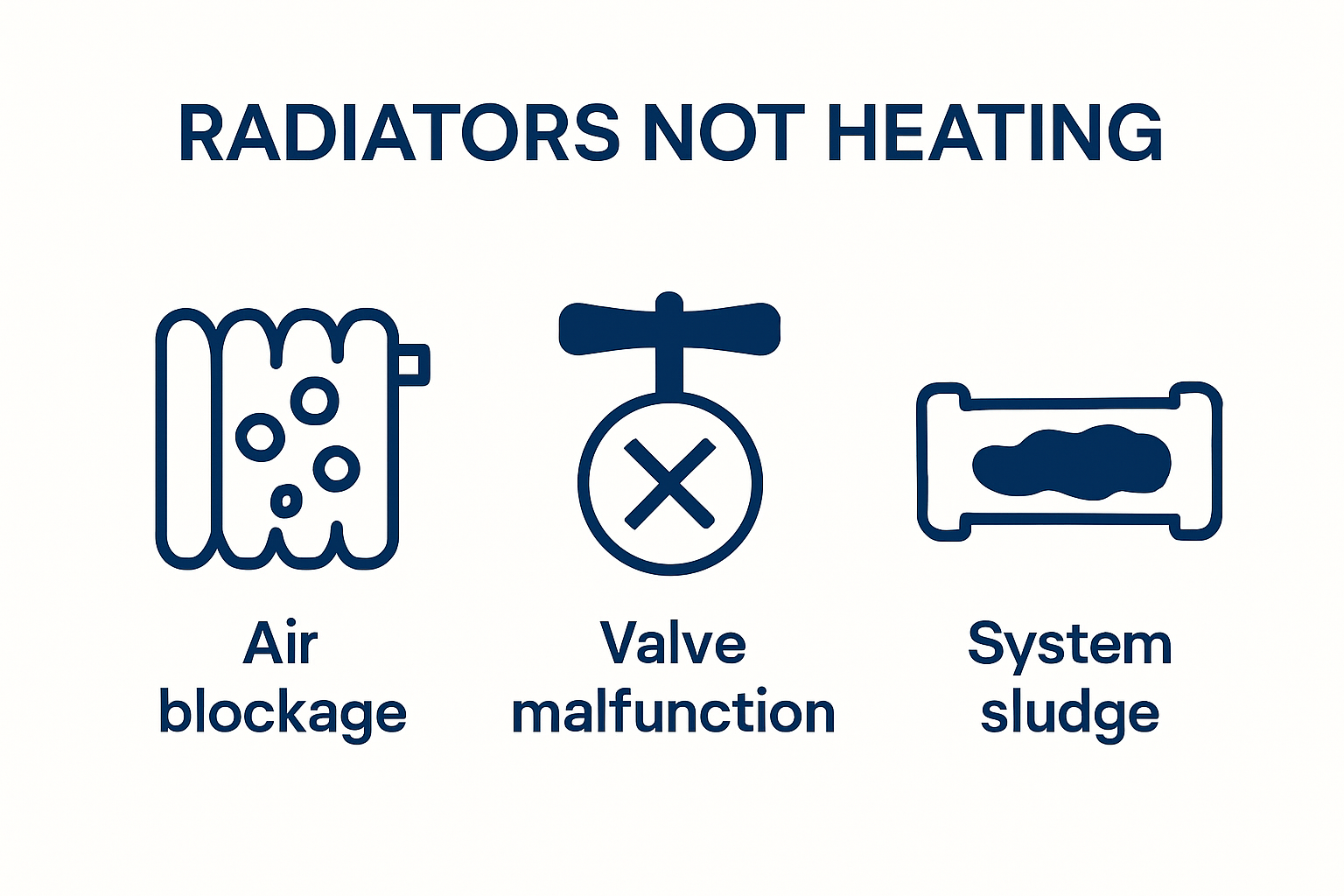
Air Blockages and Trapped Circulation
One of the most frequent problems preventing radiators from heating properly involves air trapped within the heating system. Air bubbles interrupt water circulation, creating cold spots and reducing overall thermal efficiency.
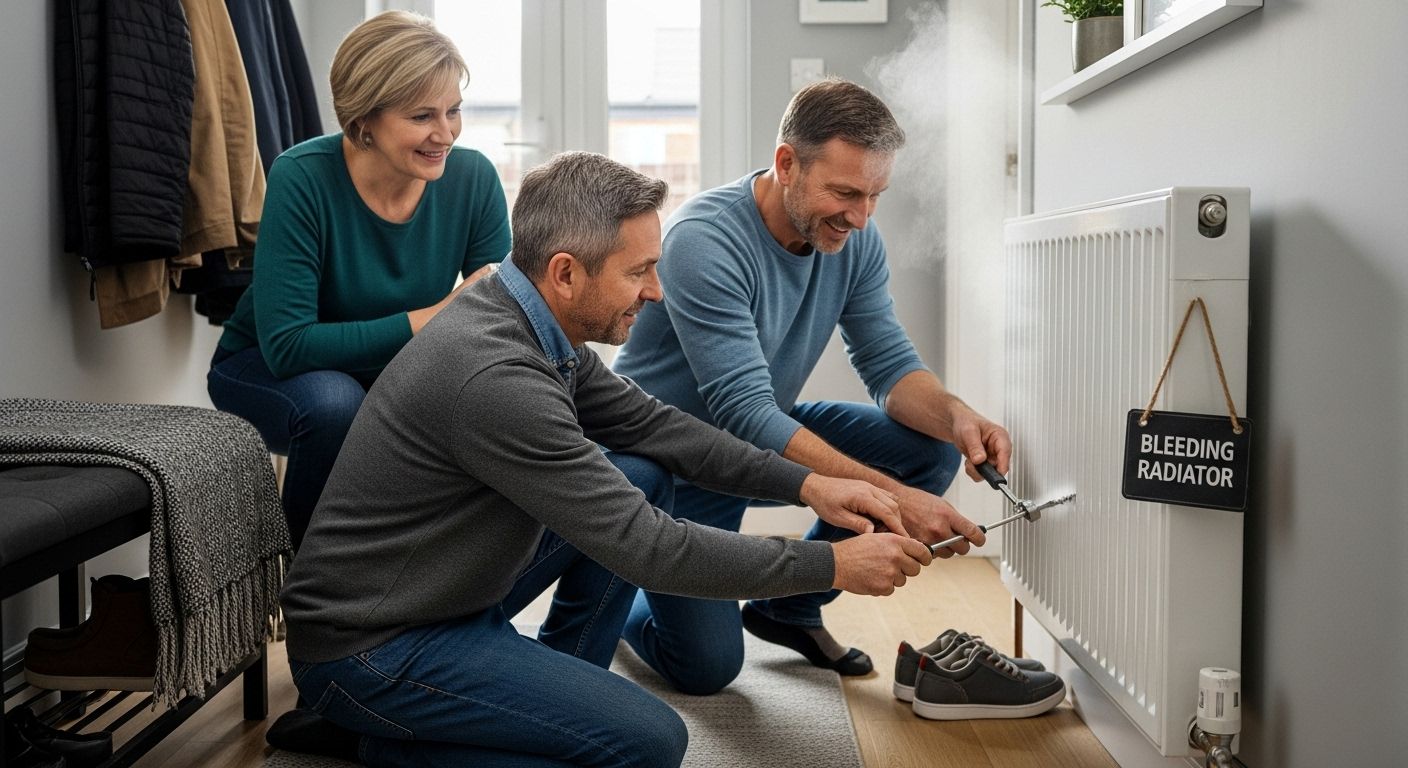
The University of Missouri Extension recommends regular radiator bleeding to remove these air pockets and restore optimal heat transfer.
Signs of air blockages include:
- Radiators feeling cold at the top but warm at the bottom
- Unusual gurgling or banging sounds within the heating system
- Inconsistent heating across different radiators
- Reduced overall heating performance
Mechanical and System-Level Complications
Multiple mechanical issues can prevent radiators from functioning correctly. These range from valve malfunctions to broader central heating system problems. Common mechanical barriers include:
- Faulty thermostatic radiator valves
- Damaged internal pipework
- Sludge and mineral deposits blocking water flow
- Broken circulation pumps
If you’re experiencing persistent heating challenges, our comprehensive boiler replacement guide can provide additional insights into maintaining an efficient heating system.
To help visualise the mechanical and system-level issues that commonly prevent radiators from heating effectively, the following table outlines typical radiator problems alongside their likely causes and signs:
| Problem | Likely Cause | Typical Signs |
|---|---|---|
| Air Blockages | Trapped air in the radiator or pipework | Cold at top, gurgling sounds, uneven heating, reduced performance |
| Valve Malfunction | Faulty thermostatic radiator valves | No temperature change when adjusted, radiator not heating |
| Sludge or Mineral Deposits | Build-up inside radiator or pipes | Radiators cool at bottom, poor heat output, discoloured water |
| Pump or Circulation Issues | Broken or inefficient circulation pump | Multiple cold radiators, system-wide heating problems |
| Damaged Pipework | Leaks or failures in internal pipes | Unusual noises, leaks, persistent lack of warmth |
Identifying and addressing these issues early prevents more significant long-term damage and ensures your home remains warm and comfortable throughout the colder months.
How Heating Systems Influence Radiator Performance
Heating systems are complex networks of interconnected components that work together to distribute thermal energy throughout a home. Understanding how these systems interact provides critical insights into radiator performance and potential operational challenges.
Boiler and Circulation Dynamics
The boiler serves as the central powerhouse of your heating system, generating hot water that circulates through radiators. System efficiency depends on multiple interconnected factors, including water temperature, pressure, and flow rate. The International Association of Certified Home Inspectors emphasises that even minor disruptions in these parameters can significantly impact overall radiator heating performance.
Key boiler-related performance factors include:
- Water temperature settings
- Pump efficiency and circulation strength
- System pressure maintenance
- Heat exchanger condition
Pipework and System Configuration
The design and condition of your home’s pipework directly influences how effectively heat transfers through radiators. Factors such as pipe diameter, material, insulation, and routing can create significant variations in thermal distribution. Older or poorly configured systems may experience:
- Reduced heat transfer efficiency
- Increased energy consumption
- Uneven heating across different rooms
- Higher likelihood of system blockages
If you are experiencing persistent heating challenges, our expert boiler replacement services can help diagnose and resolve complex system performance issues.
Recognising the intricate relationship between heating system components helps homeowners understand that radiator performance is not isolated, but part of a sophisticated thermal management ecosystem.
What Should You Consider for Effective Radiator Maintenance?
Proactive radiator maintenance is essential for ensuring optimal heating performance, energy efficiency, and preventing costly long-term system failures. Understanding key maintenance considerations helps homeowners protect their heating infrastructure and maintain comfortable living environments.
Regular Inspection and Cleaning Protocols
Routine radiator inspections form the cornerstone of effective maintenance. Dust, debris, and accumulated grime can significantly impede heat transfer and reduce overall system efficiency. Homeowners should focus on comprehensive cleaning strategies that address both external and internal radiator components.
Critical cleaning and inspection elements include:
- Removing dust and debris from radiator surfaces
- Checking for visible signs of corrosion or damage
- Ensuring radiators are not obstructed by furniture or curtains
- Examining valve functionality and seal integrity
System Pressure and Bleeding Techniques
Maintaining appropriate system pressure and removing trapped air are crucial for radiator performance. Air pockets can create cold spots and reduce heating efficiency, leading to increased energy consumption. Periodic radiator bleeding helps restore optimal thermal circulation and prevents potential mechanical complications.
Key pressure and bleeding considerations encompass:
- Monitoring system pressure gauges
- Learning proper radiator bleeding techniques
- Understanding recommended bleeding frequencies
- Recognising signs of potential pressure-related issues
If you encounter persistent maintenance challenges, our comprehensive boiler replacement guide offers additional insights into maintaining efficient heating systems.
Effective radiator maintenance is not merely about fixing problems but preventing them through consistent, proactive care and professional guidance.
Put An End To Cold Radiators With Help From Local Experts
Frustrated with radiators that are still cold no matter how much you adjust your heating? The challenges discussed above—like air blockages, stubborn cold spots, and the stress of unpredictable warmth—reflect the common problems many Edinburgh and Midlothian homes experience each winter. Knowing that issues such as trapped air, sludge build-up, or system inefficiencies can impact both your comfort and your bills, it is vital to call on trusted, professional support.

Let Thermatek’s Gas Safe Registered engineers bring real warmth back into your home. Whether you are considering a boiler replacement, looking for reliable maintenance, or want your heating system professionally inspected, our team is ready to help. Do not stay uncomfortable. Visit Thermatek Heating’s main website now to get your free quote and take the first step towards a warmer, safer, and more efficient home.
Frequently Asked Questions
What causes air blockages in radiators and how can I fix them?
Air blockages in radiators are often caused by air bubbles trapped within the heating system. You can fix this by regularly bleeding your radiators to release the trapped air, which allows hot water to circulate freely.
Why is my radiator warm at the bottom but cold at the top?
This condition typically indicates that there is air trapped at the top of the radiator, preventing hot water from circulating effectively. Bleeding the radiator will help remove the air and improve heating efficiency.
What mechanical issues can prevent my radiator from heating effectively?
Common mechanical issues include faulty thermostatic radiator valves, damaged internal pipework, and the presence of sludge or mineral deposits blocking the water flow. These issues can hinder the efficient operation of your radiator.
How does the condition of my heating system affect radiator performance?
The overall performance of your radiator is influenced by the boiler’s efficiency, the condition of the pipework, and system pressure. Minor disruptions in these areas can lead to reduced heating efficiency and uneven heating throughout your home.
Recommended
- Air Source Heat Pump Installation In Edinburgh - Thermatek Heating
- New Boiler Installation & Replacement In Edinburgh - Thermatek Heating
- Central Heating Power Flushing In Edinburgh - Thermatek Heating
- Boiler Repair In Edinburgh | 24/7 Emergency Call Out - Thermatek Heating
Understanding the Boiler Heating System for House
Boiler heating systems quietly run the show in millions of British homes, generating a steady stream of warmth through winter’s chill. Yet while most people simply turn a dial and expect instant comfort, the real magic is happening behind the scenes. A modern condensing boiler can reach up to 90 percent energy efficiency, and that leaves old-fashioned systems looking utterly outdated.
Table of Contents
- What Is A Boiler Heating System And How Does It Work?
- Why A Boiler Heating System Matters For Your Home
- Key Components And Concepts Of Boiler Heating Systems
- Types Of Boiler Heating Systems And Their Applications
- Common Issues And Considerations For Boiler Maintenance
Quick Summary
| Takeaway | Explanation |
|---|---|
| Boiler systems ensure consistent heating. | They distribute heat evenly, eliminating cold spots and providing comfortable indoor temperatures throughout your home. |
| Regular maintenance prevents breakdowns. | Proactively managing your boiler can reduce repair costs and extend its operational lifespan significantly. |
| Choosing the right boiler impacts efficiency. | Selecting a design that matches your household’s needs directly influences energy consumption and operational costs. |
| Modern boilers offer environmental benefits. | Advanced technologies in contemporary boilers help lower energy use and reduce your carbon footprint. |
| Different boiler types serve varied needs. | Understanding diverse boiler configurations allows homeowners to choose the best fit for their home’s heating requirements. |
What is a Boiler Heating System and How Does It Work?
A boiler heating system is a fundamental residential heating solution that generates warmth by heating water or producing steam to distribute heat throughout a home. Unlike traditional heating methods, boilers create a comprehensive thermal network that efficiently transfers thermal energy across multiple rooms.
The Core Mechanism of Boiler Systems
At its essence, a boiler heating system operates through a sophisticated thermodynamic process. The system begins by heating water or generating steam within a central unit, typically powered by gas, electricity, or oil. Our comprehensive guide to boiler replacements provides deeper insights into these technological variations.
The fundamental stages of boiler operation include:
- Water or fluid is heated to a specific temperature within the primary chamber
- Heated water or steam circulates through radiators or underfloor heating pipes
- Heat is transferred from the water or steam into surrounding living spaces
- A return system captures cooled water and recirculates it for reheating
Types of Boiler Heating Technologies
Boiler systems are not uniform but represent diverse technological approaches. According to Energy Saving Trust, the primary boiler categories include:
- Combi boilers: Compact units providing instant hot water and heating
- System boilers: Featuring separate hot water storage cylinders
- Conventional boilers: Traditional designs with separate water tanks
Each design offers unique advantages depending on household size, energy requirements, and architectural configurations.
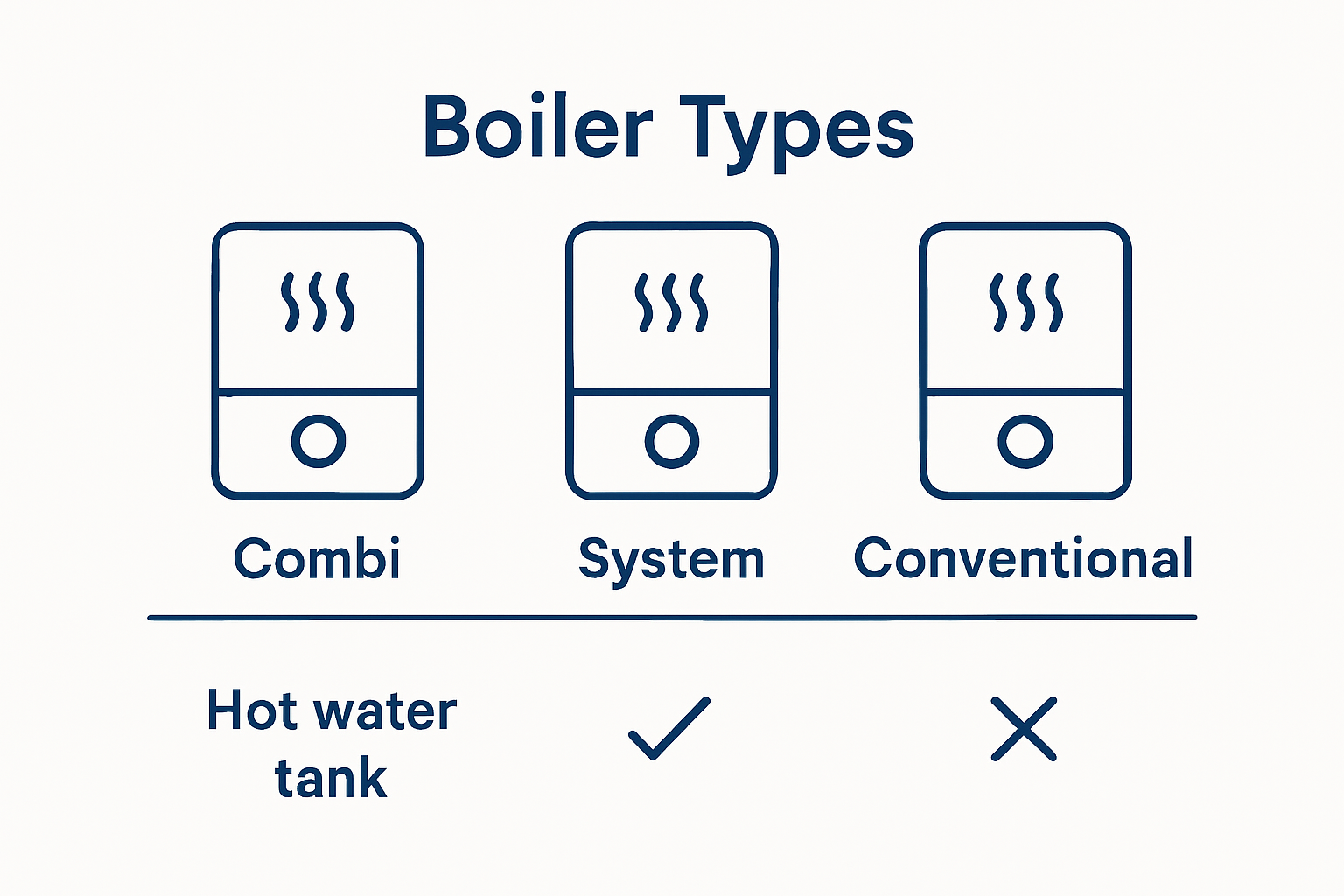
The selection determines overall heating efficiency, energy consumption, and long term operational costs. Modern boiler heating systems prioritize energy conservation, integrating smart technologies that optimise thermal management and reduce environmental impact.
Why a Boiler Heating System Matters for Your Home
Boiler heating systems represent more than just a method of warming your living space. They are sophisticated technological solutions that deliver comprehensive comfort, energy efficiency, and long term economic benefits for homeowners.
Comfort and Consistent Heating Performance
A well-designed boiler heating system ensures uniform warmth throughout your home. Unlike traditional heating methods that create temperature variations, boilers distribute heat evenly across rooms, eliminating cold spots and providing consistent thermal comfort. Our expert boiler replacement services can help optimise this critical home comfort feature.
Key advantages of boiler heating systems include:
- Precise temperature control
- Silent operation compared to forced air systems
- Reduced dust circulation
- Potential allergy and respiratory health benefits
Economic and Environmental Considerations
According to Energy Saving Trust, modern boiler systems can significantly reduce household energy consumption. The technological sophistication of contemporary boilers translates into direct financial savings and reduced carbon footprint.
The economic benefits extend beyond immediate energy savings:
- Lower long term operational costs
- Potential government energy efficiency incentives
- Increased property value through modern heating infrastructure
- Reduced maintenance requirements compared to older heating systems
By selecting an appropriate boiler heating system, homeowners invest in a reliable, efficient, and environmentally responsible home heating solution that balances personal comfort with broader sustainability goals.
Key Components and Concepts of Boiler Heating Systems
Boiler heating systems represent complex thermal engineering networks with interconnected components designed to efficiently generate and distribute heat throughout residential spaces. Understanding these components provides insight into the sophisticated mechanics behind modern home heating technologies.
Primary Boiler System Elements
The core components of a boiler heating system work in precise synchronisation to transform energy into usable thermal output. Our comprehensive boiler replacement guide offers deeper technical insights into these intricate systems.
Critical system components include:
- Heat exchanger: Transfers thermal energy between water and heating medium
- Burner: Generates initial heat through fuel combustion
- Circulating pump: Moves heated water through distribution networks
- Expansion tank: Manages water volume changes during heating cycles
- Control mechanisms: Regulate temperature and operational parameters
Thermal Distribution and Control Mechanisms
According to National Renewable Energy Laboratory, effective boiler systems integrate advanced control technologies that optimise energy transfer and consumption. These systems employ sophisticated thermostatic controls that continuously monitor and adjust heating performance.
Key control and distribution concepts include:
- Zoned heating capabilities
- Smart thermostat integration
- Predictive temperature management
- Automated efficiency protocols
By understanding these fundamental components, homeowners can appreciate the technological complexity underlying their heating infrastructure and make informed decisions about system maintenance, upgrades, and energy efficiency strategies.
Understanding the core components of a boiler system helps homeowners make informed decisions regarding maintenance and upgrades. The following table defines the major elements and their primary roles:
| Component | Function |
|---|---|
| Heat Exchanger | Transfers heat from the burner to the water |
| Burner | Generates heat through fuel combustion |
| Circulating Pump | Moves heated water around the distribution system |
| Expansion Tank | Accommodates water volume changes during heating cycles |
| Control Mechanisms | Regulate temperature and control system operation |
| Radiators/Underfloor | Distribute heat into living spaces |
| Thermostat | Monitors and adjusts temperature for comfort and efficiency |
Types of Boiler Heating Systems and Their Applications
Boiler heating systems encompass diverse technological approaches, each designed to meet specific residential heating requirements. Understanding these variations enables homeowners to select the most appropriate solution for their unique living environments.
Fuel-Based Boiler Classification
The primary categorisation of boiler systems stems from their fuel source and operational mechanisms. Our comprehensive heat pump installation services demonstrate the evolving landscape of residential heating technologies.
Boiler systems can be classified based on fuel types:
- Gas boilers: Most common, utilising natural gas for heating
- Oil boilers: Traditional systems using heating oil
- Electric boilers: Emerging technology with zero direct emissions
- Biomass boilers: Sustainable options using organic materials
Thermal Delivery and Design Configurations
According to National Institutes of Health research, modern boiler systems increasingly prioritise environmental sustainability and energy efficiency. The thermal delivery methodology significantly influences system performance and residential comfort.
Key boiler system design configurations include:
- Combi boilers: Compact units providing instant hot water and heating
- System boilers: Featuring separate hot water storage cylinders
- Conventional boilers: Traditional designs with separate water tanks
- Condensing boilers: Advanced technology capturing waste heat for improved efficiency
Each configuration offers distinct advantages, enabling homeowners to balance performance, space requirements, and energy consumption based on their specific household needs.
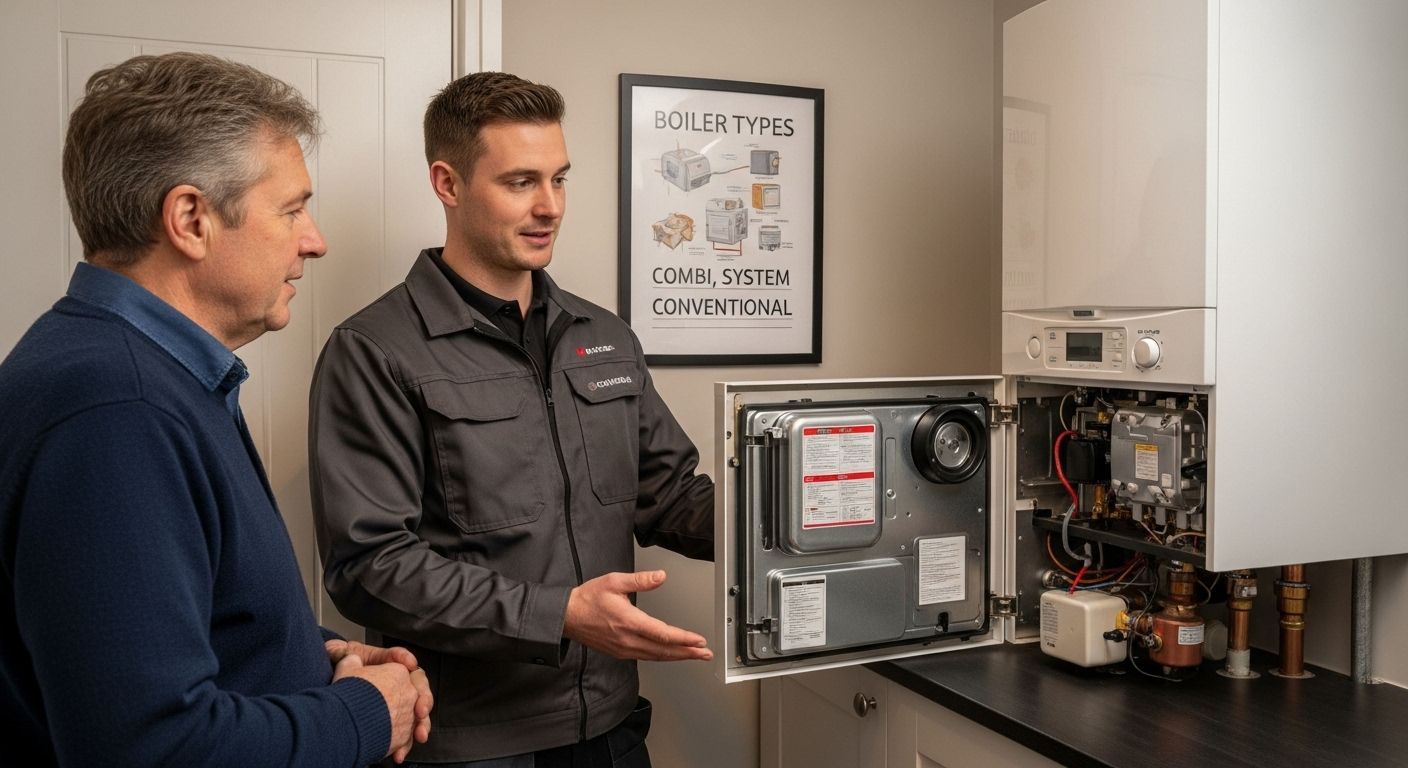
Common Issues and Considerations for Boiler Maintenance
Boiler maintenance represents a critical aspect of ensuring long term system performance, energy efficiency, and household safety. Proactive management prevents costly repairs and extends the operational lifespan of heating infrastructure.
Critical Diagnostic Indicators
Homeowners must remain vigilant about recognising potential system irregularities. Our comprehensive boiler replacement services can help address complex maintenance challenges before they escalate.
Key warning signs requiring immediate attention include:
- Unusual noises during heating cycles
- Inconsistent water temperature
- Visible water leakage
- Increased energy consumption
- Persistent pilot light issues
Preventative Maintenance Strategies
According to U.S. Department of Energy research, systematic maintenance significantly improves boiler reliability and operational efficiency. Professional interventions can mitigate potential system failures and optimise thermal performance.
Essential maintenance considerations include:
- Annual professional inspection
- Regular cleaning of heat exchanger surfaces
- Checking and replacing safety valves
- Monitoring system pressure levels
- Assessing combustion efficiency
By implementing comprehensive maintenance protocols, homeowners protect their heating investment and ensure consistent, safe thermal comfort throughout their living spaces.
Upgrade Your Comfort and Efficiency with Professional Boiler Solutions
If you are frustrated by uneven heating, rising energy bills or the worry of an unreliable boiler system, you do not have to face these issues alone. Your home deserves a heating system that delivers both comfort and efficiency. As highlighted in our article, the right boiler setup enables precise temperature control, energy savings and healthier living. It is essential to trust experienced professionals for services like boiler replacement, annual servicing and reliable repairs. This is the best way to protect your investment and keep your home comfortable all year round.

Take control of your home’s warmth and safety today. Visit thermatekheating.co.uk to explore our full range of accredited heating solutions, request a free quote or get expert advice from our Gas Safe engineers. Make the switch to a dependable heating partner now, and experience the difference a professional touch brings.
Frequently Asked Questions
What are the main components of a boiler heating system?
The primary components of a boiler heating system include the heat exchanger, burner, circulating pump, expansion tank, and control mechanisms. These parts work together to heat water, distribute it, and manage the heating process efficiently.
How does a boiler heating system differ from traditional heating methods?
Unlike traditional heating methods that can create temperature variations, boiler heating systems provide uniform warmth throughout the home by circulating heated water or steam through radiators or underfloor pipes, ensuring consistent comfort.
What types of boilers are available for home heating?
Boiler systems can be categorized primarily into combi boilers, system boilers, conventional boilers, gas boilers, oil boilers, electric boilers, and biomass boilers. Each type has unique features and advantages tailored to different household needs and preferences.
To help you compare the main types of boilers available for home heating, the following table summarises their key characteristics and suitability:
| Boiler Type | Key Features | Best For |
|---|---|---|
| Combi Boiler | Compact, provides instant hot water and heating | Smaller homes, limited space |
| System Boiler | Separate hot water storage cylinder, good flow rate | Medium to large homes, multiple bathrooms |
| Conventional Boiler | Traditional, uses separate water tank and cylinder | Older homes, high hot water demand |
| Gas Boiler | Runs on natural gas, widely available | Most UK homes, efficient for many sizes |
| Oil Boiler | Uses heating oil, traditional for off-grid homes | Properties without gas supply |
| Electric Boiler | Runs on electricity, zero direct emissions | Small flats, properties without gas |
| Biomass Boiler | Uses organic material as fuel, eco-friendly option | Eco-conscious homeowners, rural areas |
What are common issues that may arise with boiler systems?
Common issues with boiler systems include unusual noises during operation, inconsistent water temperature, visible leaks, increased energy consumption, and pilot light problems. Addressing these signs promptly can prevent more significant issues and maintain system efficiency.
Recommended
- New Boiler Installation & Replacement In Edinburgh - Thermatek Heating
- Air Source Heat Pump Installation In Edinburgh - Thermatek Heating
- Boiler Repair In Edinburgh | 24/7 Emergency Call Out - Thermatek Heating
- Annual Boiler Servicing In Edinburgh - Thermatek Heating
7 Key Comparisons: Combi Boiler vs System Boiler
Choosing the right boiler shapes how comfortable and efficient your home feels. Combi and system boilers dominate UK homes, yet most people miss the fact that combi boilers can reduce unnecessary energy consumption by up to 30% compared to traditional systems. It sounds like a clear winner but the real surprise is how the best choice can actually depend more on your bathroom schedule and the number of people under your roof than on headline-grabbing efficiency numbers.
Table of Contents
- Understanding Combi Boilers: Basics Explained
- Understanding System Boilers: Basics Explained
- Efficiency: Comparing Combi and System Boilers
- Installation: Which Boiler Type Is Easier?
- Space Requirements: Combi Vs System Boilers
- Hot Water Supply: Key Differences Explained
- Costs and Maintenance: Budgeting for Your Boiler
Quick Summary
| Takeaway | Explanation |
|---|---|
| Combi boilers provide instant hot water | They heat water directly from the mains, ensuring no wait time for hot water availability. |
| System boilers best for larger households | They include a hot water cylinder, allowing multiple taps to deliver water simultaneously without pressure drops. |
| Combi boilers are space-efficient | Their compact design eliminates the need for separate storage tanks, making them ideal for smaller homes. |
| Consider installation complexity | Combi boilers are easier to install than system boilers, requiring less space and fewer components. |
| Evaluate long-term energy costs | Although combi boilers have lower initial costs, families may benefit from the higher hot water capacity of system boilers. |
1: Understanding Combi Boilers: Basics Explained
Combi boilers represent a modern, compact heating solution that has transformed residential heating systems across the United Kingdom. Unlike traditional boiler setups, these innovative units combine water heating and central heating functionality within a single, streamlined device. According to the U.S. Department of Energy, understanding the core mechanics of these systems can help homeowners make informed decisions about their heating infrastructure.
At their core, combi boilers operate on a straightforward principle: they heat water directly from the mains supply, eliminating the need for separate hot water storage tanks. This direct approach offers several significant advantages:
- Instant Hot Water: No waiting for water to heat up from a storage cylinder
- Space Efficiency: Compact design ideal for smaller properties
- Energy Conservation: Reduced heat loss compared to traditional systems
The heating mechanism involves sophisticated heat exchangers that rapidly warm water as it passes through the boiler. When you turn on a hot water tap, cold water enters the boiler, gets heated instantly by a gas burner, and then flows directly to your tap or shower. This process ensures on-demand hot water without maintaining a constant reservoir of heated water.
For Edinburgh homeowners considering a heating upgrade, understanding boiler replacement options can provide valuable insights into modernising home heating systems. Combi boilers are particularly suited to properties with limited space and smaller households, offering a blend of efficiency and convenience that traditional systems cannot match.
Technically, these boilers operate most effectively in homes with one or two bathrooms, where simultaneous hot water demands are relatively low. Their ability to provide immediate hot water at mains pressure makes them an attractive option for many modern households seeking streamlined, energy-efficient heating solutions.
2: Understanding System Boilers: Basics Explained
System boilers represent a robust and versatile heating solution designed for larger properties with multiple bathrooms and higher hot water demands. Unlike combi boilers, these systems incorporate a separate hot water cylinder that stores heated water, providing a consistent and substantial hot water supply. According to the Open University, understanding the technical nuances of system boilers can help homeowners make informed heating infrastructure decisions.
The core functionality of system boilers involves several key components that distinguish them from other heating systems:
- Central Heating Unit: Directly heats water for radiators and cylinder
- Hot Water Cylinder: Stores and maintains heated water for domestic use
- Multiple Outlet Capability: Supports simultaneous hot water usage across different taps
These boilers are particularly well-suited for households with higher hot water requirements. The integrated hot water cylinder allows multiple bathrooms and appliances to draw hot water simultaneously without experiencing pressure drops or temperature fluctuations. This makes system boilers an excellent choice for larger families or properties with significant hot water needs.
Our boiler replacement service can help homeowners transition to these efficient heating systems. Modern system boilers are typically condensing models, which means they recover and reuse heat that would traditionally be lost through exhaust gases, significantly improving overall energy efficiency.
The primary advantage of system boilers lies in their ability to provide consistent and abundant hot water. While they require more space than combi boilers due to the additional hot water cylinder, they offer superior performance in homes with multiple bathrooms or high simultaneous hot water demands. Homeowners can expect reliable heating and hot water supply, making system boilers a pragmatic choice for comprehensive home heating solutions.
3: Efficiency: Comparing Combi and System Boilers
Boiler efficiency represents a critical consideration for homeowners seeking optimal heating performance and energy conservation. According to the U.S. Department of Energy, understanding the nuanced efficiency differences between combi and system boilers can significantly impact long-term energy consumption and household expenses.
When comparing efficiency, several key factors differentiate these two boiler types:
- Energy Conversion: Combi boilers typically achieve higher direct efficiency due to instantaneous heating
- Heat Loss: System boilers experience more heat loss through their storage cylinders
- Operating Temperatures: Condensing models in both systems can improve overall efficiency
Combi boilers excel in efficiency due to their on-demand heating mechanism. By heating water precisely when required, they eliminate standby energy losses associated with maintaining a constant hot water reservoir. This approach can reduce unnecessary energy consumption by up to 30% compared to traditional heating systems.
System boilers, while slightly less efficient, offer distinct advantages for larger households. The hot water cylinder, though introducing some heat loss, provides a more consistent and substantial hot water supply. Modern insulated cylinders minimise energy waste, making contemporary system boilers increasingly competitive in efficiency ratings.
Our boiler replacement experts recommend considering household-specific requirements when evaluating efficiency. Factors such as property size, number of occupants, and hot water demand play crucial roles in determining the most energy-efficient solution.
Ultimately, both combi and system boilers can deliver high-performance heating when selected and installed appropriately. Homeowners should prioritise modern condensing models, which leverage advanced heat exchange technologies to maximise energy conversion and minimise environmental impact.
4: Installation: Which Boiler Type is Easier?
Installation complexity represents a significant factor when selecting between combi and system boilers. According to the Air-Conditioning, Heating, and Refrigeration Institute, understanding the nuanced installation requirements can help homeowners make informed decisions about their heating infrastructure.
Combi boilers generally offer simpler installation processes due to their compact, all-in-one design. Key installation advantages include:
- Minimal Space Requirements: No separate hot water cylinder needed
- Reduced Pipework: Fewer connections and components
- Quicker Installation Time: Typically completed within one day
System boilers, conversely, demand more complex installation procedures. Significant considerations for system boiler installations involve:
- Dedicated space for hot water cylinder
- More extensive pipework and connections
- Potential requirement for additional insulation
The physical footprint plays a crucial role in installation ease. Combi boilers can be mounted on walls and integrated into compact spaces, making them ideal for smaller properties. System boilers require additional space for the hot water cylinder, which might necessitate dedicated airing cupboard or utility room accommodation.
Our professional boiler replacement service recommends assessing individual property characteristics before making a final decision. Factors such as available space, hot water demand, and existing infrastructure significantly influence the installation complexity and overall suitability of each boiler type.
While combi boilers generally present a more straightforward installation process, modern system boilers have become increasingly streamlined. Professional installation remains key to ensuring optimal performance, efficiency, and long-term reliability, regardless of the chosen boiler system.
5: Space Requirements: Combi vs System Boilers
Space efficiency represents a critical consideration when selecting between combi and system boilers, directly impacting property layout and design possibilities. According to Design Horizons, understanding the spatial requirements of each boiler type can help homeowners make informed decisions about their heating infrastructure.
Combi boilers excel in space conservation, offering remarkable advantages for compact properties:
- Compact Single Unit: No separate hot water cylinder required
- Wall-Mountable Design: Can be installed in small cupboards or tight spaces
- No Additional Water Tanks: Eliminates need for loft or airing cupboard storage
System boilers, in contrast, demand more substantial spatial accommodation. Key space considerations include:
- Dedicated hot water cylinder space
- Potential requirement for additional insulation
- Larger overall heating system footprint
Our boiler replacement specialists recommend carefully measuring available space before selecting a system. Typically, system boilers require an additional 100-150 litres of cylinder space, which might necessitate a dedicated airing cupboard or utility room.
For apartments, small terraced homes, or properties with limited square footage, combi boilers present a clear spatial advantage. Their integrated design eliminates the need for separate water storage components, making them ideal for modern, space-constrained living environments. Homeowners with larger properties or higher hot water demands might find the additional space investment in a system boiler worthwhile for its consistent water supply and potential for increased capacity.
6: Hot Water Supply: Key Differences Explained
Hot water supply represents a critical consideration when selecting between combi and system boilers, with each design offering distinct advantages for different household requirements. According to the Air-Conditioning, Heating, and Refrigeration Institute, understanding these differences can help homeowners make informed heating infrastructure decisions.
Combi boilers provide instantaneous hot water directly from the mains supply, offering several unique characteristics:
- Immediate Water Heating: Water heated precisely when required
- Consistent Mains Pressure: Delivers strong water flow across taps
- Limited Simultaneous Usage: Best suited for smaller households
System boilers, in contrast, store heated water in a dedicated cylinder, presenting alternative hot water management strategies:
- Large Volume Hot Water Storage: Supports multiple simultaneous users
- Consistent Water Temperature: Maintains steady hot water supply
- Ideal for Larger Households: Can serve multiple bathrooms simultaneously
Our boiler replacement experts recommend evaluating household hot water demands carefully. Combi boilers excel in properties with one or two occupants, where instant hot water and space efficiency are paramount. Larger families or homes with multiple bathrooms might find system boilers more accommodating, offering a more substantial and consistent hot water reservoir.
The primary distinction lies in hot water generation and storage. Combi boilers heat water on demand, eliminating storage tank requirements and reducing heat loss. System boilers maintain a pre-heated water cylinder, enabling higher volume hot water delivery but potentially experiencing minor heat dissipation through the storage unit. Ultimately, the choice depends on individual household size, hot water consumption patterns, and spatial constraints.
7: Costs and Maintenance: Budgeting for Your Boiler
Boiler costs and maintenance represent significant long-term investments for homeowners, with substantial variations between combi and system boiler configurations. According to the U.S. Department of Energy, understanding maintenance requirements and potential efficiency savings can help households make informed financial decisions.
Initial Investment Considerations for boiler selection include:
- Combi Boilers: Generally lower upfront installation costs
- System Boilers: Higher initial purchase and installation expenses
- Long-Term Energy Efficiency: Critical factor in overall financial planning
Maintenance Requirements differ significantly between boiler types:
- Combi Boilers: Fewer components, typically lower annual maintenance costs
- System Boilers: More complex systems requiring more frequent professional servicing
- Cylinder Maintenance: Additional maintenance for system boiler hot water storage units
Our comprehensive boiler replacement service recommends considering annual operational expenses beyond initial installation. High-efficiency condensing boilers can reduce energy consumption by up to 20%, translating to significant long-term savings.
Running costs depend on multiple factors including household size, hot water demand, and local energy prices. Combi boilers often prove more economical for smaller households, with reduced heat loss and fewer mechanical components. System boilers, while potentially more expensive to maintain, offer greater hot water capacity for larger families.
Homeowners should budget for annual professional servicing, typically costing between £70-£120, which helps prevent unexpected breakdowns and maintains optimal boiler performance. Strategic maintenance can extend boiler lifespan by 5-10 years, representing substantial potential savings over the system’s operational period.
Choose the Right Boiler for Your Home with Thermatek
Struggling to decide between the instant hot water of a combi boiler and the higher capacity of a system boiler? Many homeowners face confusion when balancing space, efficiency, and long-term costs. As the article points out, finding the ideal solution is not always straightforward. You want reliable heating, consistent hot water, and a system that fits your property perfectly.

Take the guesswork out of upgrading your heating. Our Gas Safe Registered engineers at Thermatek Heating provide tailored consultations and expert boiler replacements to ensure your new system matches your needs. Whether you need a compact solution or require extra capacity for a busy household, Thermatek’s trusted team delivers safe, efficient, and fully accredited installation. Explore our full boiler replacement service today and secure a free quote. Act now to enjoy lower energy bills and reliable comfort all year round.
Frequently Asked Questions
What is the main difference between combi boilers and system boilers?
Combi boilers heat water directly from the mains supply, providing instant hot water without the need for a storage tank. System boilers, on the other hand, have a separate hot water cylinder that stores heated water, making them better suited for larger households with higher hot water demands.
Which boiler type is more efficient?
Combi boilers typically achieve higher energy efficiency due to their on-demand heating, eliminating standby losses. System boilers, while slightly less efficient, can provide a more consistent hot water supply for larger families using multiple taps simultaneously.
What are the space requirements for combi and system boilers?
Combi boilers are more compact and can fit into smaller spaces since they don’t require a separate hot water cylinder. In contrast, system boilers require additional space for the hot water cylinder, making them less suitable for smaller properties.
How do the costs and maintenance of combi and system boilers compare?
Combi boilers generally have lower upfront installation costs and reduced maintenance due to fewer components. System boilers tend to have higher initial costs and maintenance needs because of their complexity, especially regarding the maintenance of the hot water cylinder.
Recommended
- New Boiler Installation & Replacement In Edinburgh - Thermatek Heating
- Air Source Heat Pump Installation In Edinburgh - Thermatek Heating
- Boiler Repair In Edinburgh | 24/7 Emergency Call Out - Thermatek Heating
- Central Heating Power Flushing In Edinburgh - Thermatek Heating
Understanding How Often to Service Your Boiler
A boiler is the heart of a warm and comfortable home, quietly powering radiators and hot water for daily life. Most people think of it as a straightforward gadget, only there to boil water on cold days. Yet here’s the surprise. Modern boilers can convert up to 90 percent of fuel into usable heat, making them far more efficient and valuable than people realise. This unexpected figure is just the beginning of what every homeowner needs to know about their boiler’s real impact.
Table of Contents
- What Is A Boiler And Its Function In Your Home?
- Why Regular Boiler Servicing Is Essential?
- How Boiler Servicing Contributes To Energy Efficiency
- Factors Influencing Boiler Servicing Frequency
- Understanding The Risks Of Neglecting Boiler Maintenance
Quick Summary
| Takeaway | Explanation |
|---|---|
| Regular servicing prevents costly repairs | Routine maintenance helps identify issues early, avoiding expensive repairs down the line. |
| Boiler type influences servicing frequency | Different boiler types and ages require variable maintenance schedules for optimal performance. |
| Neglecting maintenance poses safety hazards | Poorly maintained boilers can lead to serious risks, including carbon monoxide leaks and system failures. |
| Professional servicing boosts energy efficiency | Regular maintenance optimises boiler performance, reducing energy consumption and utility bills. |
| Understanding water hardness impacts boiler upkeep | Areas with hard water may need more frequent servicing to prevent mineral buildup and inefficiencies. |
What is a Boiler and Its Function in Your Home?
A boiler is a fundamental heating system that plays a crucial role in maintaining comfort and warmth within residential properties. Unlike common misconceptions, a boiler does more than simply boil water - it is a sophisticated appliance designed to heat water and distribute warmth throughout your home via radiators, underfloor heating, or hot water taps.
The Core Mechanism of Boiler Operation
At its core, a boiler works by heating water through a combustion process, typically using natural gas, oil, or electricity. The heated water or steam is then circulated through a network of pipes and radiators, transferring heat efficiently to warm your living spaces. The Energy Saving Trust confirms that modern boilers can convert up to 90% of fuel into usable heat, making them significantly more efficient than older models.
Types of Boilers in Residential Settings
Boilers come in several varieties, each suited to different home configurations and heating requirements:
- Combi Boilers: Compact units that provide heating and hot water directly from the mains, ideal for smaller properties
- System Boilers: Suitable for homes with multiple bathrooms, storing hot water in a separate cylinder
- Regular Boilers: Traditional systems with separate cold water tank and hot water cylinder, common in older properties
Understanding your specific boiler type helps in maintaining its efficiency and longevity, ensuring consistent warmth and hot water supply throughout your home.
Below is a table comparing the different types of residential boilers, highlighting their main features and common usage scenarios to help homeowners identify their own system and its needs.
| Boiler Type | Key Features | Typical Usage Scenario |
|---|---|---|
| Combi Boiler | Compact, provides heating & hot water directly from mains | Smaller properties, limited space |
| System Boiler | Requires hot water cylinder, no cold water tank | Homes with multiple bathrooms |
| Regular Boiler | Traditional; separate cold water tank & hot water cylinder | Older properties, larger households |
Why Regular Boiler Servicing is Essential?
Regular boiler servicing is a critical maintenance practice that protects your home’s heating system, ensures optimal performance, and prevents potentially costly breakdowns. Just like a car requires routine maintenance, your boiler needs professional attention to function efficiently and safely throughout its operational lifespan.
Safety and Performance Implications
Boiler servicing goes far beyond routine maintenance. It is a comprehensive inspection that identifies potential safety risks and performance issues before they escalate. The U.S. Department of Energy emphasizes that annual maintenance helps prevent serious safety concerns such as carbon monoxide leaks, which can pose significant health risks to your household.
Key Benefits of Regular Professional Servicing
Regular boiler servicing provides multiple critical advantages:
- Efficiency Optimization: Professional servicing ensures your boiler operates at peak efficiency, reducing energy consumption and lowering utility bills
- Extended Equipment Lifespan: Routine maintenance prevents premature wear and can significantly extend your boiler’s operational years
- Early Problem Detection: Technicians can identify and address minor issues before they develop into major, expensive repairs
By investing in professional boiler maintenance services, homeowners can protect their heating system, ensure consistent performance, and maintain a safe living environment.
How Boiler Servicing Contributes to Energy Efficiency
Boiler servicing plays a pivotal role in maintaining and enhancing the overall energy efficiency of your home heating system. By ensuring that your boiler operates at peak performance, regular maintenance can significantly reduce energy consumption and lower utility costs.
The Direct Impact on Energy Performance
Professional boiler servicing involves a comprehensive examination of all system components, which directly influences energy efficiency. The U.S. Department of Energy confirms that routine maintenance, including cleaning and calibrating system components, can substantially improve heat transfer and system performance.
Key Efficiency Improvement Strategies
During a professional service, technicians implement several strategies to optimize energy efficiency:
- Cleaning Critical Components: Removing dust, debris, and scale buildup from heat exchangers and burners
- Calibration of System Settings: Adjusting combustion settings to ensure optimal fuel-to-air ratios
- Identifying and Repairing Minor Issues: Detecting potential inefficiencies before they become major problems
By investing in comprehensive boiler maintenance, homeowners can achieve a more energy-efficient heating system that not only reduces energy consumption but also minimizes environmental impact and lowers monthly utility expenses.
Factors Influencing Boiler Servicing Frequency
Boiler servicing frequency is not a one-size-fits-all approach but depends on multiple interconnected factors that vary across different households and heating systems. Understanding these factors helps homeowners develop a proactive maintenance strategy that ensures optimal boiler performance and longevity.
Age and Type of Boiler System
The age and specific type of your boiler significantly impact how often it requires professional servicing. Newer condensing boilers might need less frequent maintenance compared to older traditional models. Gas Safe Register recommends annual servicing as a standard practice, but the exact frequency can depend on your boiler’s manufacturer specifications and overall condition.
Usage Patterns and Environmental Considerations
Boiler servicing frequency is closely tied to how intensively the system is used and the environmental conditions it operates within. Factors that influence servicing needs include:
- Heating Intensity: Homes with constant or high-demand heating require more frequent servicing
- Water Hardness: Areas with hard water can cause faster mineral buildup, necessitating more regular maintenance
- System Age: Older boilers typically need more frequent professional inspections
- Manufacturer Recommendations: Each boiler model has specific maintenance guidelines
By understanding these variables, homeowners can develop a tailored approach to boiler maintenance and replacement that protects their heating investment and ensures consistent performance.
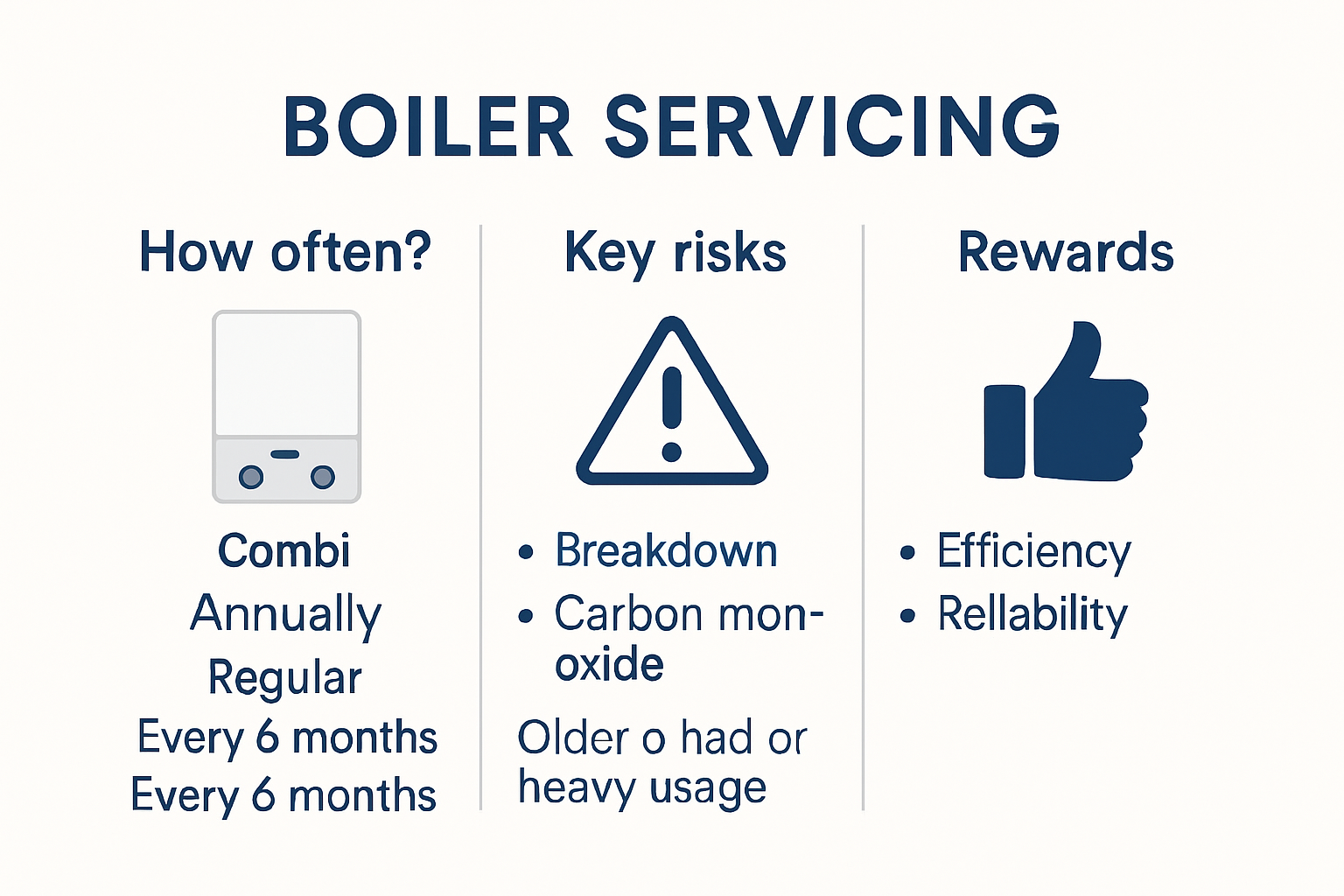
Understanding the Risks of Neglecting Boiler Maintenance
Neglecting boiler maintenance is a dangerous practice that can lead to significant safety hazards, substantial financial costs, and potential catastrophic system failures. Homeowners who overlook regular professional servicing expose themselves to risks that extend far beyond simple mechanical breakdown.
Safety Hazards and Health Risks
Boiler neglect can create life-threatening situations within your home. The Roman Catholic Archdiocese of Boston emphasizes that improper maintenance can result in severe consequences including potential carbon monoxide poisoning, fire risks, and even system explosions. These risks underscore the critical importance of consistent professional inspection and maintenance.
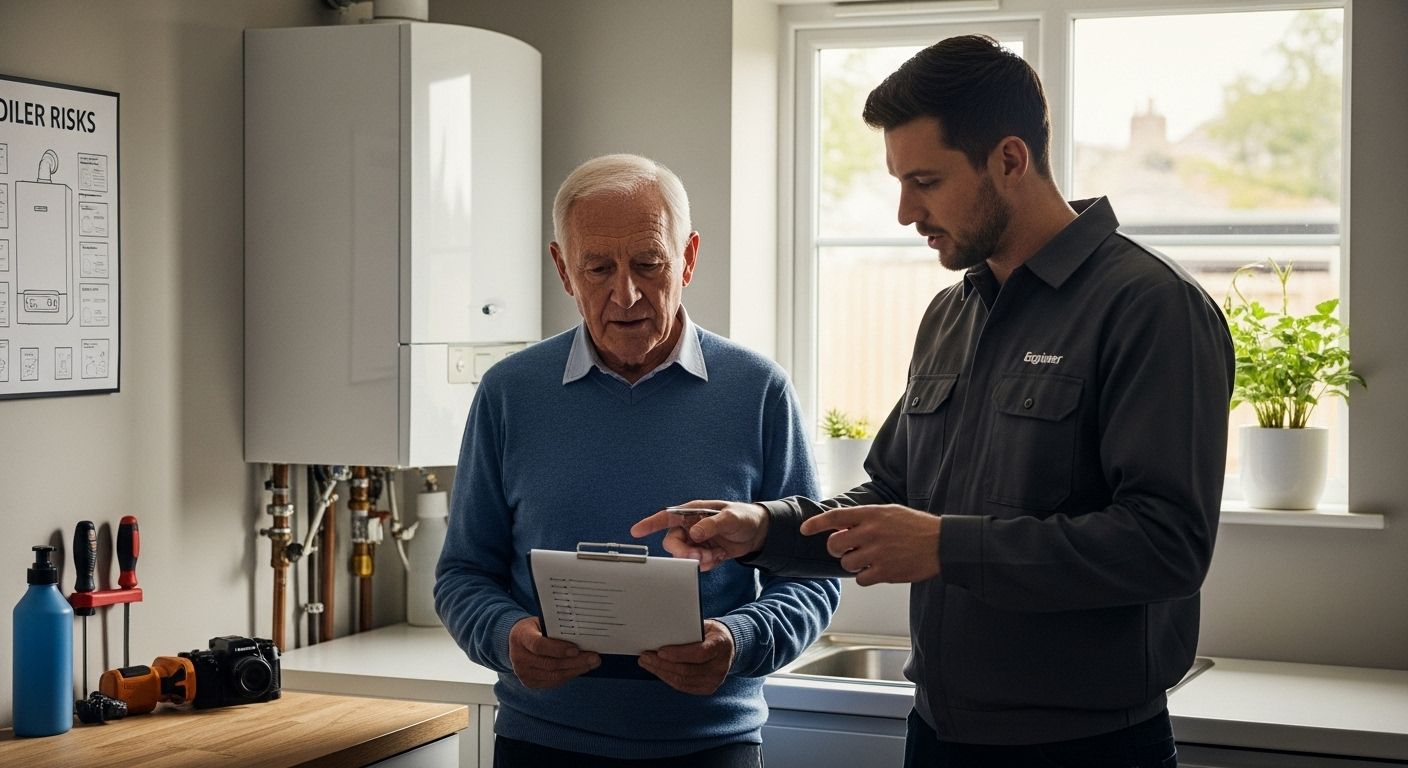
Financial and Performance Implications
Beyond immediate safety concerns, neglecting boiler maintenance carries significant financial and operational risks:
- Accelerated System Deterioration: Unmaintained boilers experience faster wear and component failure
- Increased Energy Consumption: Poorly maintained systems operate less efficiently, leading to higher utility bills
- Unexpected Repair Costs: Minor issues left unaddressed can escalate into expensive major repairs
- Reduced System Lifespan: Consistent neglect can significantly shorten your boiler’s operational years
By investing in professional boiler maintenance services, homeowners can mitigate these risks, ensuring both safety and long-term financial prudence.
Take Control of Your Boiler’s Health and Your Home’s Safety
Worried about hidden safety risks or higher bills because your boiler servicing schedule is uncertain? If reading about the importance of regular boiler maintenance in this guide made you wonder whether your own system is truly protected, you are not alone. Many homeowners in Edinburgh and Midlothian struggle with knowing how often to check their boilers, risking not only costly breakdowns but also serious hazards like carbon monoxide exposure and lost efficiency. Reliable, professionally scheduled servicing is the solution that delivers peace of mind and consistent heating performance all year.

Choose Thermatek for expert boiler servicing you can trust. Our Gas Safe Registered engineers use years of local experience to keep your system running safely and efficiently. Whether you need routine servicing, urgent repairs, or want advice on energy-efficient upgrades, our team can help. Unlock the full comfort and security of your home—visit Thermatek Heating now to request your free quote and secure your professional service appointment today.
Frequently Asked Questions
How often should I service my boiler?
Annual servicing is recommended for most boiler types to ensure safety and efficiency. However, factors such as the boiler’s age and usage patterns may affect this frequency.
What are the risks of neglecting boiler maintenance?
Neglecting boiler maintenance can lead to safety hazards such as carbon monoxide leaks, fire risks, and significantly increased energy bills due to inefficiency.
How can I tell if my boiler needs servicing?
Signs that your boiler may need servicing include unusual noises, inconsistent heating, higher energy bills, and warning lights on the boiler’s display.
What does a boiler service typically include?
A typical boiler service includes a thorough inspection of the system, cleaning critical components, checking for leaks, and ensuring that safety mechanisms function correctly.
Recommended
- New Boiler Installation & Replacement In Edinburgh - Thermatek Heating
- Annual Boiler Servicing In Edinburgh - Thermatek Heating
- Central Heating Power Flushing In Edinburgh - Thermatek Heating
- Boiler Repair In Edinburgh | 24/7 Emergency Call Out - Thermatek Heating
Understanding Commercial Heating Solutions for Your Property
Commercial heating solutions are powering everything from academic halls to sprawling hospitals and modern office towers. But the scale is jaw-dropping. Some advanced heat pump systems can actually slash energy costs by up to 50 percent compared to older technologies. Most surprising of all, the real challenge is not just about generating heat for big spaces. It is about weaving together smart technology, sustainability and strict safety rules in ways most people never imagine.
Table of Contents
- What Are Commercial Heating Solutions?
- Why Are Commercial Heating Solutions Important?
- How Do Different Commercial Heating Systems Work?
- Key Concepts In Commercial Heating Solutions
- Real-World Applications Of Commercial Heating Solutions
Quick Summary
| Takeaway | Explanation |
|---|---|
| Commercial heating systems are specialised for larger spaces | They manage complex thermal dynamics and energy demands effectively, unlike residential systems. |
| Advanced technologies improve energy efficiency | Utilising high-efficiency heat pumps can cut energy costs by up to 50%, enhancing operational savings. |
| Proper heating systems boost employee productivity | Maintaining optimal temperatures supports cognitive function and reduces fatigue, improving workplace performance. |
| Regulatory compliance is essential for businesses | Strict health and safety regulations mandate appropriate thermal conditions in professional environments. |
| Sustainable heating technologies are increasingly used | Integrating renewable energy sources is crucial for reducing carbon emissions and operational costs. |
What Are Commercial Heating Solutions?
Commercial heating solutions represent sophisticated systems designed to manage temperature and climate control for various business and institutional environments. These comprehensive heating technologies go far beyond traditional residential heating methods, addressing complex spatial requirements and delivering precise thermal management across diverse professional settings.
Understanding the Core Principles
At their fundamental level, commercial heating solutions are engineered heating systems specifically tailored for larger spaces such as office buildings, industrial facilities, educational institutions, healthcare centres, and commercial properties. Unlike residential systems, these solutions must accommodate significantly more complex thermal dynamics, higher energy demands, and more stringent performance standards.
Key characteristics of commercial heating solutions include:
- Advanced temperature regulation capabilities
- Enhanced energy efficiency designs
- Scalable infrastructure adaptable to different building sizes
- Integration with smart building management technologies
Technological Diversity in Commercial Heating
Commercial heating technologies encompass multiple sophisticated approaches. Hydronic heating systems utilise heated water circulated through radiators or underfloor networks, providing uniform warmth across expansive areas. Forced air systems employ powerful fans to distribute heated air through extensive ductwork, ensuring rapid temperature adjustments in large commercial spaces.
According to the U.S. Department of Energy, high-efficiency heat pump technologies can reduce energy costs by up to 50% compared to conventional commercial heating systems. This statistic underscores the significant technological advancements transforming commercial heating infrastructure.
Modern commercial heating solutions also increasingly incorporate renewable energy technologies, such as geothermal heat pumps and solar thermal systems, reflecting a growing commitment to sustainable and environmentally responsible heating strategies.
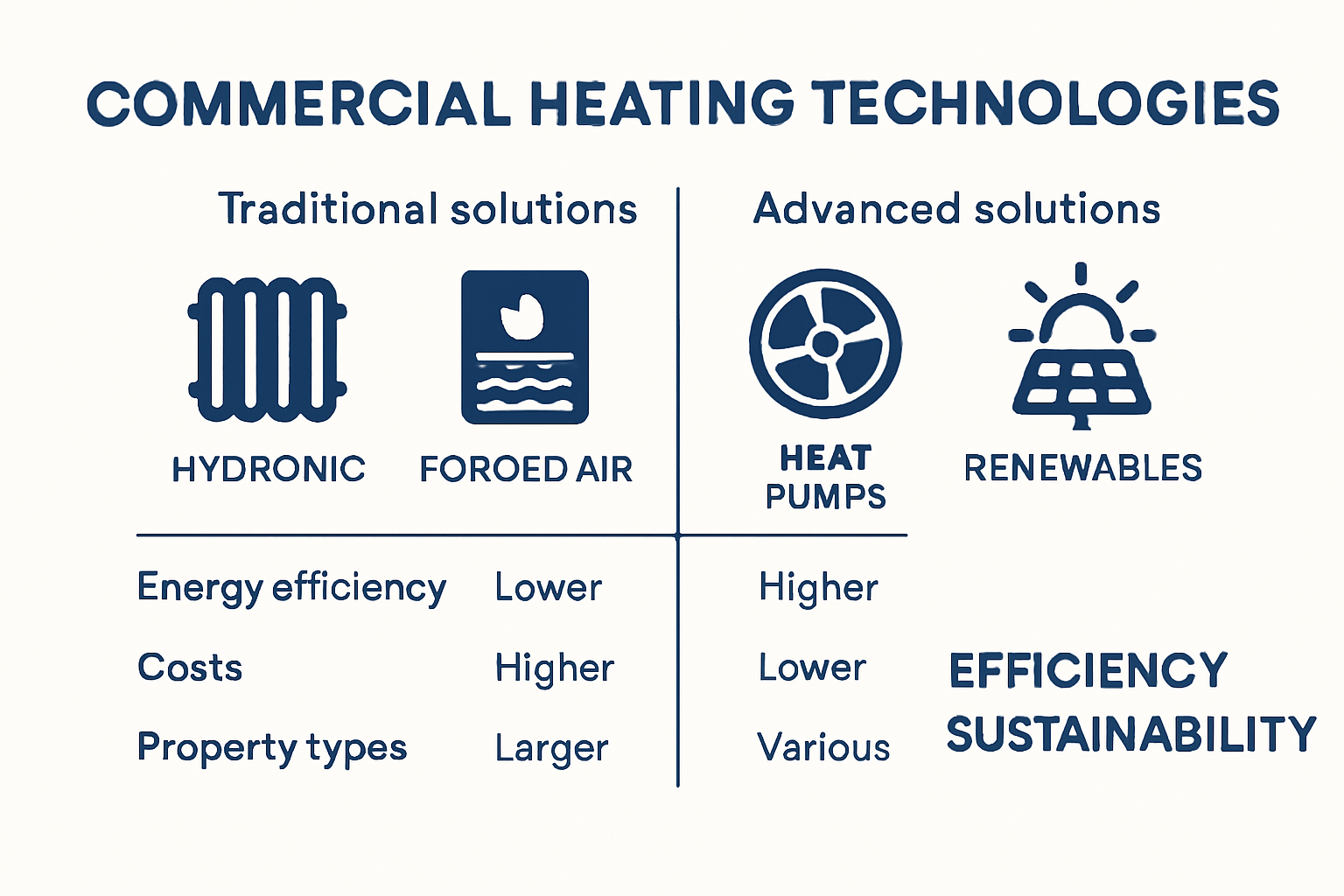
These innovative approaches not only provide effective temperature management but also contribute to reducing carbon emissions and operational costs for businesses.
Why Are Commercial Heating Solutions Important?
Commercial heating solutions play a critical role in maintaining optimal working environments, ensuring operational efficiency, employee well-being, and regulatory compliance across various professional and institutional settings. Their importance extends far beyond simple temperature management, encompassing complex considerations of comfort, productivity, safety, and economic performance.
Employee Health and Productivity
Proper heating systems directly impact workplace performance and human physiological well-being. Maintaining appropriate temperatures is not merely about comfort but about creating environments that support cognitive function and physical health. Consistent thermal regulation helps prevent issues such as reduced concentration, increased fatigue, and potential health risks associated with extreme temperature variations.
The following table summarises key impacts of proper commercial heating on employee health and productivity, as discussed in the article:
| Impact Area | How Proper Heating Supports It |
|---|---|
| Core Body Temperature Maintenance | Prevents drops or spikes that harm health/productivity |
| Reduced Stress & Physical Strain | Less discomfort leads to focus and fewer absences |
| Consistent Mental Focus | Avoids distractions and fatigue from temperature swings |
| Lower Workplace Health Risks | Reduces risk of cold/heat-related illnesses and injuries |
| Enhanced Productivity | Optimises concentration, supports higher performance |
Key impacts on employee performance include:
- Maintaining optimal core body temperature
- Reducing stress and physical strain
- Supporting consistent mental focus
- Minimising potential workplace health risks
Economic and Operational Efficiency
Beyond human factors, commercial heating solutions represent significant economic investments that influence operational costs and infrastructure sustainability. Modern heating technologies offer sophisticated energy management capabilities, enabling businesses to reduce utility expenses while maintaining high-performance standards. Strategic heating system selection can result in substantial long-term financial savings and improved operational resilience.
According to the Centers for Disease Control and Prevention, proper workplace heating is essential for maintaining indoor air quality and thermal comfort, which directly correlates with worker productivity and organisational performance.
Regulatory Compliance and Safety Standards
Commercial heating solutions are not optional but mandatory requirements in most professional environments. Businesses must adhere to strict health and safety regulations that mandate appropriate thermal conditions. These standards protect employee welfare, prevent potential workplace health hazards, and ensure environments meet legal occupational requirements. Modern heating technologies provide robust mechanisms for maintaining these critical safety benchmarks while delivering efficient, reliable temperature management across diverse commercial landscapes.
How Do Different Commercial Heating Systems Work?
Commercial heating systems represent complex technological infrastructures designed to provide precise thermal management across diverse professional environments. These sophisticated systems employ multiple mechanisms to generate, distribute, and regulate heat, ensuring optimal temperature control for various commercial and institutional settings.
To help clarify the main types of commercial heating systems and how they operate, here is a comparison table of their core characteristics and mechanisms:
| System Type | Heat Generation Method | Distribution Mechanism | Notable Features |
|---|---|---|---|
| Hydronic Heating | Heated water (boilers) | Radiators/underfloor piping | Uniform warmth, energy-efficient |
| Forced Air Systems | Combustion/electric resistance/heat pumps | Ductwork with powerful fans | Rapid temperature changes, large coverage |
| Combustion-based Systems | Fossil fuel combustion (gas, oil) | Varies (air or water) | Robust output, traditional method |
| Electrical Resistance | Electrical to heat via elements | Fans or radiators | Quick installation, simple design |
| Heat Pump Systems | Transfer heat from outside sources | Air ducts or hydronic piping | Can cut costs by up to 50%, eco-friendly |
| Renewable Energy Systems | Geothermal/solar thermal conversion | Piping or air distribution | Sustainable, reduces carbon footprint |
Fundamental Heating Generation Mechanisms
Commercial heating technologies utilise several core methods for heat generation, each with unique operational characteristics. Combustion-based systems burn fossil fuels like natural gas or oil to produce thermal energy, while electrical resistance heating converts electrical energy directly into heat through specialised heating elements.
Key heat generation approaches include:
- Direct fuel combustion technologies
- Electrical resistance heating methods
- Heat pump systems extracting thermal energy from external sources
- Renewable energy thermal conversion technologies
Advanced Thermal Distribution Technologies
Once heat is generated, commercial systems employ sophisticated distribution mechanisms to ensure uniform temperature management. Hydronic systems circulate heated water through intricate piping networks, delivering consistent warmth across large spaces. Forced air systems utilise powerful fans and extensive ductwork to rapidly distribute heated air, enabling quick temperature adjustments in expansive commercial environments.
According to the National Renewable Energy Laboratory, advanced solar process heat technologies can be integrated into commercial heating infrastructure, offering innovative approaches to thermal management that leverage renewable energy sources.
Smart Control and Energy Management
Modern commercial heating solutions increasingly incorporate intelligent control systems that optimise energy consumption and thermal efficiency. These advanced technologies use sensors, programmable thermostats, and machine learning algorithms to dynamically adjust heating output based on occupancy, external temperature, and specific spatial requirements. Zonal heating controls enable precise temperature management across different areas within a single commercial facility, maximising comfort while minimising energy wastage and operational costs.
Key Concepts in Commercial Heating Solutions
Commercial heating solutions represent sophisticated technological ecosystems comprising intricate design principles, energy management strategies, and thermal performance metrics. Understanding these core concepts is essential for businesses seeking efficient, sustainable, and cost-effective heating infrastructures that meet complex professional environment requirements.
Thermal Efficiency and Performance Metrics
Thermal efficiency stands as a fundamental concept in commercial heating systems, measuring the proportion of energy successfully converted into usable heat. This metric goes beyond simple temperature generation, evaluating how effectively heating technologies transform input energy into consistent, reliable thermal output across diverse commercial spaces.
Key performance indicators include:
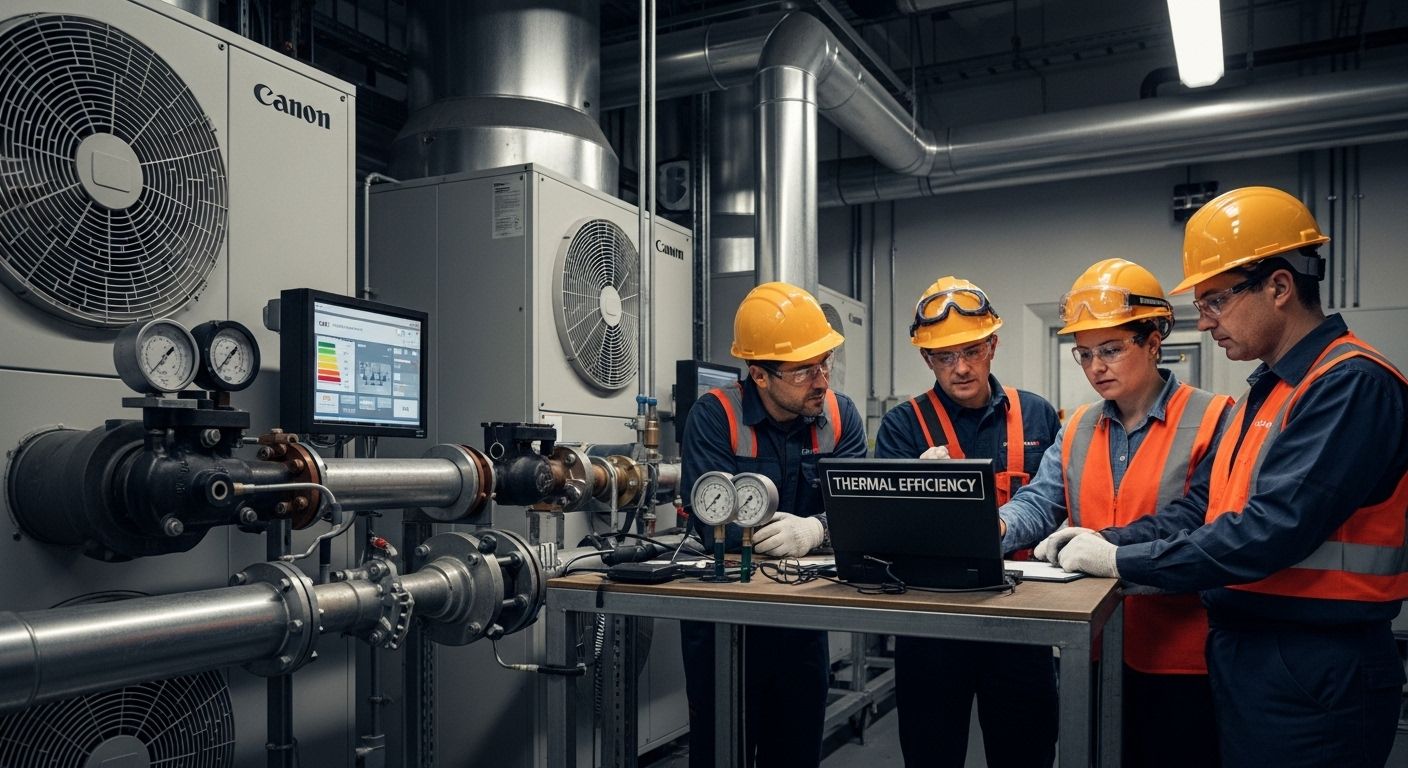
- Heat transfer coefficient
- Energy consumption rates
- Temperature consistency
- System responsiveness
- Thermal uniformity across different zones
Energy Management and Sustainability Principles
Modern commercial heating solutions increasingly emphasise sustainable design principles that balance operational performance with environmental responsibility. Renewable integration and carbon footprint reduction have become critical considerations in heating system selection and design. Advanced technologies now incorporate intelligent energy management strategies that dynamically adjust thermal output based on real-time occupancy, external temperature variations, and specific spatial requirements.
According to the U.S. Department of Energy, emerging electrification strategies are transforming commercial heating infrastructure, supporting broader decarbonisation objectives while maintaining high-performance standards.
Technological Adaptability and Future Readiness
The most sophisticated commercial heating solutions prioritise technological adaptability, ensuring systems can evolve alongside emerging energy technologies and regulatory landscapes. Modular design approaches enable businesses to incrementally upgrade heating infrastructures without complete system replacement. This concept supports long-term investment protection while facilitating seamless integration of emerging renewable and energy-efficient technologies.
Businesses seeking comprehensive heating solutions might explore professional boiler replacement services to ensure their thermal management infrastructure remains cutting-edge and aligned with contemporary performance standards.
Real-World Applications of Commercial Heating Solutions
Commercial heating solutions transcend theoretical concepts, finding critical applications across diverse professional environments where thermal management directly impacts operational efficiency, occupant comfort, and organisational performance. These sophisticated systems address complex heating requirements in sectors ranging from healthcare and education to manufacturing and hospitality.
Healthcare and Medical Facilities
Precision temperature control represents a fundamental requirement in medical environments where thermal stability can significantly influence patient care and medical equipment performance. Commercial heating solutions in healthcare settings must maintain consistent temperatures across various zones, from patient rooms to sterile operating theatres, ensuring optimal conditions for medical procedures and patient recovery.
Key application areas include:
- Critical care unit temperature management
- Laboratory and research facility thermal regulation
- Surgical suite environmental control
- Pharmaceutical storage temperature maintenance
- Medical equipment performance optimization
Industrial and Manufacturing Environments
Manufacturing facilities demand robust heating solutions that can withstand extreme operational conditions while maintaining precise thermal environments. Industrial heating systems must accommodate diverse requirements such as material processing, equipment performance, and worker comfort. These solutions integrate advanced thermal management technologies that support complex industrial processes across different production stages.
According to the U.S. Department of Energy, emerging high-temperature heat pump technologies are revolutionising thermal management in industrial settings, offering unprecedented efficiency and temperature control capabilities.
Commercial and Institutional Spaces
Office buildings, educational institutions, and public facilities represent critical domains where commercial heating solutions directly influence human productivity and well-being. These environments require flexible heating systems capable of adapting to varying occupancy levels, spatial configurations, and temporal temperature fluctuations. Professional heating infrastructure upgrades enable organisations to implement intelligent, energy-efficient thermal management strategies that balance operational costs with optimal environmental conditions.
Unlock Reliable Commercial Heating for Your Business Needs
Struggling to keep your property comfortable and energy-efficient with a complex heating system? You are certainly not alone. The article highlighted key commercial heating challenges such as managing large spaces, ensuring thermal consistency, meeting regulatory compliance and cutting unnecessary costs. Many businesses in Edinburgh and Midlothian face similar headaches, especially when older systems let you down during critical times. Effective thermal management and advanced solutions such as zonal controls or smart upgrades are not simply nice-to-haves—they are essential to productivity and staff well-being.

Why settle for unreliable or inefficient commercial heating? Choose expertly installed and maintained solutions by Gas Safe Registered engineers at Thermatek, your dependable local team. From boiler replacement services designed for modern business environments to energy-saving renewable solutions, our trustworthy support helps you create a safer, more cost-effective workplace. Do not wait for winter to reveal costly weaknesses—get your free quote today and see how Thermatek can future-proof your building.
Frequently Asked Questions
What are commercial heating solutions?
Commercial heating solutions are advanced heating systems designed for larger spaces such as office buildings, industrial facilities, and educational institutions. They offer precise thermal management and energy efficiency tailored to the complex needs of commercial environments.
How do hydronic heating systems work in commercial settings?
Hydronic heating systems circulate heated water through radiators or underfloor networks, providing consistent warmth across large areas. This technology ensures uniform temperature distribution and can be more energy-efficient than traditional heating methods.
What are the benefits of using high-efficiency heat pumps in commercial heating?
High-efficiency heat pumps can reduce energy costs by up to 50% compared to conventional heating systems. They are designed to provide effective heating while minimising energy use, making them a sustainable choice for commercial applications.
Why is proper heating important for employee productivity?
Proper heating directly impacts employee comfort, concentration, and overall health. Maintaining optimal temperatures helps prevent fatigue and health risks, contributing to improved workplace performance and productivity.
Recommended
- New Boiler Installation & Replacement In Edinburgh - Thermatek Heating
- Boiler Repair In Edinburgh | 24/7 Emergency Call Out - Thermatek Heating
- Central Heating Power Flushing In Edinburgh - Thermatek Heating
Understanding Landlord Gas Safety Certificates: What You Need to Know
Renting out property might seem straightforward and yet every year around 50 people in the UK die from carbon monoxide poisoning linked to faulty gas appliances. You might think this sort of disaster is an unpredictable freak occurrence and yet it is often entirely avoidable. The surprising fact is that a little piece of paper called a landlord gas safety certificate could be the simple document standing between safe tenants and a major crisis.
Table of Contents
- What Are Landlord Gas Safety Certificates?
- The Importance of Gas Safety Certificates for Landlords
- How Landlord Gas Safety Certificates Protect Tenants
- Key Components of a Gas Safety Certificate
- Understanding the Legal Obligations for Landlords
Quick Summary
| Takeaway | Explanation |
|---|---|
| Landlords must obtain gas safety certificates annually | UK law requires landlords to secure certificates for all rental properties with gas appliances each year. |
| Safety checks prevent serious health risks | Regular inspections identify gas leaks and ensure safe appliance operation, significantly reducing the risk of carbon monoxide poisoning. |
| Non-compliance leads to severe consequences | Failure to secure a certificate can result in heavy fines, legal prosecution, and invalid insurance policies for landlords. |
| Certificates enhance tenant confidence | Providing gas safety documentation fosters trust and demonstrates landlords’ commitment to tenant welfare and property safety. |
| Thorough inspections cover critical safety aspects | Inspections include checks on gas appliances, ventilation systems, and carbon monoxide levels, ensuring comprehensive safety monitoring for tenants. |
What Are Landlord Gas Safety Certificates?
A landlord gas safety certificate represents a critical legal document that verifies the safe condition of gas appliances and installations within a rental property. This official record confirms that all gas equipment has been professionally inspected and meets stringent safety standards, protecting both tenants and property owners from potential hazards.
The Fundamental Purpose of Gas Safety Certificates
Gas safety certificates serve as comprehensive documentation of a thorough examination conducted by a Gas Safe Registered engineer. These certificates are not merely paperwork but a critical safeguard against potentially life-threatening risks such as gas leaks, carbon monoxide poisoning, and potential explosions. The primary objectives include:
- Confirming all gas appliances are functioning correctly
- Identifying any potential safety risks or malfunctions
- Ensuring compliance with current legal regulations
- Protecting tenant health and property integrity
Under UK law, landlords are legally obligated to obtain these certificates annually for every rental property featuring gas appliances. The certification process involves a comprehensive inspection that goes beyond a simple checklist, requiring meticulous assessment of all gas-related installations.
Legal Requirements and Implications
Landlords who fail to secure a valid gas safety certificate face significant legal consequences. According to Health and Safety Executive, non-compliance can result in substantial fines, potential imprisonment, and invalidation of property insurance. The law mandates that landlords must:
- Arrange annual safety checks by qualified professionals
- Provide tenants with a copy of the certificate within 28 days of inspection
- Maintain records of all gas safety inspections for at least two years
- Ensure all gas appliances and flues are maintained in safe working condition
The certificate itself becomes a crucial document that demonstrates a landlord’s commitment to tenant safety and legal responsibility. By prioritizing these inspections, property owners not only protect themselves from potential legal repercussions but also create a safer living environment for their tenants.
The Importance of Gas Safety Certificates for Landlords
Gas safety certificates are more than bureaucratic documentation for rental properties. They represent a critical mechanism for protecting human life, preventing property damage, and maintaining legal compliance. These certificates serve as an essential risk management tool that transcends simple regulatory requirements.
Protecting Human Life and Property
The fundamental significance of gas safety certificates lies in their capacity to prevent potentially fatal incidents. Carbon monoxide and gas leaks pose silent but extreme dangers that can result in serious health complications or fatal outcomes. According to The Gas Safety Trust, carbon monoxide poisoning results in approximately 50 deaths annually in the UK, making proactive safety measures crucial.
Key life-saving aspects of these certificates include:
- Identifying hidden gas appliance defects
- Detecting potential carbon monoxide leakage points
- Verifying proper ventilation and combustion processes
- Ensuring appliances operate within manufacturer specifications
Legal and Financial Implications
Beyond safety considerations, gas safety certificates carry significant legal and financial ramifications for landlords. Failure to obtain and maintain these documents can trigger severe consequences that extend far beyond potential safety risks. Non-compliance can result in:
- Substantial financial penalties
- Potential legal prosecution
- Invalidation of property insurance
- Automatic breach of tenancy agreements
Landlords who neglect their gas safety responsibilities expose themselves to substantial financial and legal vulnerabilities. The modest investment required for annual inspections represents a minimal expense compared to potential litigation, property damage, or personal injury claims.
Moreover, these certificates demonstrate a landlord’s professional commitment to tenant welfare. They establish a transparent record of responsible property management, potentially enhancing tenant trust and potentially improving long-term rental relationships. By prioritizing safety through comprehensive gas inspections, landlords protect not just their tenants but also their own professional reputation and financial interests.
How Landlord Gas Safety Certificates Protect Tenants
Landlord gas safety certificates are fundamental safeguards that create a comprehensive protective framework for tenants, ensuring their living environments remain secure from potential gas-related hazards. These certificates represent a proactive approach to preventing dangerous incidents and maintaining high standards of residential safety.
Comprehensive Safety Monitoring
Gas safety certificates provide a systematic approach to identifying and mitigating potential risks within rental properties. By mandating thorough professional inspections, these documents create multiple layers of protection for tenants. According to The Gas Safety Advice Centre, these inspections cover critical aspects of gas infrastructure that could potentially compromise tenant safety.
Key protective elements include:
- Detailed examination of all gas appliances
- Comprehensive assessment of ventilation systems
- Precise measurement of carbon monoxide levels
- Verification of correct installation and maintenance procedures
Health and Preventative Measures
Beyond immediate safety checks, gas safety certificates function as a critical preventative health mechanism. They address silent threats that might otherwise go unnoticed, such as carbon monoxide leakage or subtle equipment malfunctions. These certificates help identify potential health risks before they escalate into life-threatening situations.
The inspection process involves multiple protective strategies:
- Checking for potential gas leaks
- Ensuring proper combustion processes
- Validating equipment performance standards
- Assessing potential carbon monoxide emission risks
Tenants benefit from these rigorous inspections as they receive documented evidence of their living space’s safety. The certificates provide transparency, allowing residents to understand the condition of their gas appliances and feel confident in their accommodation’s safety standards. By legally requiring landlords to conduct these annual inspections, the regulatory framework ensures that tenants have an additional layer of protection against potential gas-related dangers.
Key Components of a Gas Safety Certificate
A gas safety certificate represents a meticulously structured document that provides comprehensive evidence of professional safety assessment for gas installations and appliances. Far from being a simple checklist, this certificate encompasses detailed technical evaluations that ensure residential and commercial environments meet stringent safety standards.
Technical Documentation and Inspection Elements
Gas safety certificates contain multiple critical sections that collectively provide a holistic assessment of gas infrastructure. According to Gas Safe Register, these documents must include precise details about each examined component, creating a transparent record of the property’s gas system condition.
Key technical documentation typically encompasses:
- Unique certificate identification number
- Detailed property address information
- Complete list of inspected gas appliances
- Specific serial numbers of examined equipment
- Name and registration number of the examining engineer
Comprehensive Safety Assessment Criteria
The following table breaks down the typical elements checked and recorded in a gas safety certificate. This overview aids landlords and tenants in understanding what is included in a standard gas safety inspection.
| Certificate Component | Explanation |
|---|---|
| Certificate Identification Number | Unique number for tracking and referencing each gas safety certificate. |
| Property Address | Precise details of the rental property inspected. |
| List of Gas Appliances | Comprehensive record of all appliances/equipment checked during inspection. |
| Appliance Serial Numbers | Unique identifiers for each gas appliance, ensuring traceable records. |
| Engineer Details | Name and Gas Safe registration number of the inspecting engineer. |
| Inspection Results | Summary of safety assessment findings, including any identified risks or issues. |
| Date of Inspection | Specifies when the inspection took place and aids in tracking annual compliance. |
The certificate goes beyond simple documentation, serving as a forensic examination of potential gas-related risks. Qualified Gas Safe Registered engineers conduct systematic evaluations that scrutinize multiple safety parameters. These assessments involve sophisticated diagnostic processes designed to identify even subtle potential hazards.
Critical safety assessment elements include:
- Thorough visual inspection of gas appliances
- Precise measurement of gas pressure and flow rates
- Comprehensive combustion efficiency testing
- Detailed evaluation of ventilation systems
- Carbon monoxide emission level measurements
Each component of the gas safety certificate represents a crucial layer of protection, transforming what might appear to be routine paperwork into a vital safety document. By capturing granular details about gas installations, these certificates provide landlords, tenants, and regulatory bodies with an authoritative record of equipment condition and potential risks.
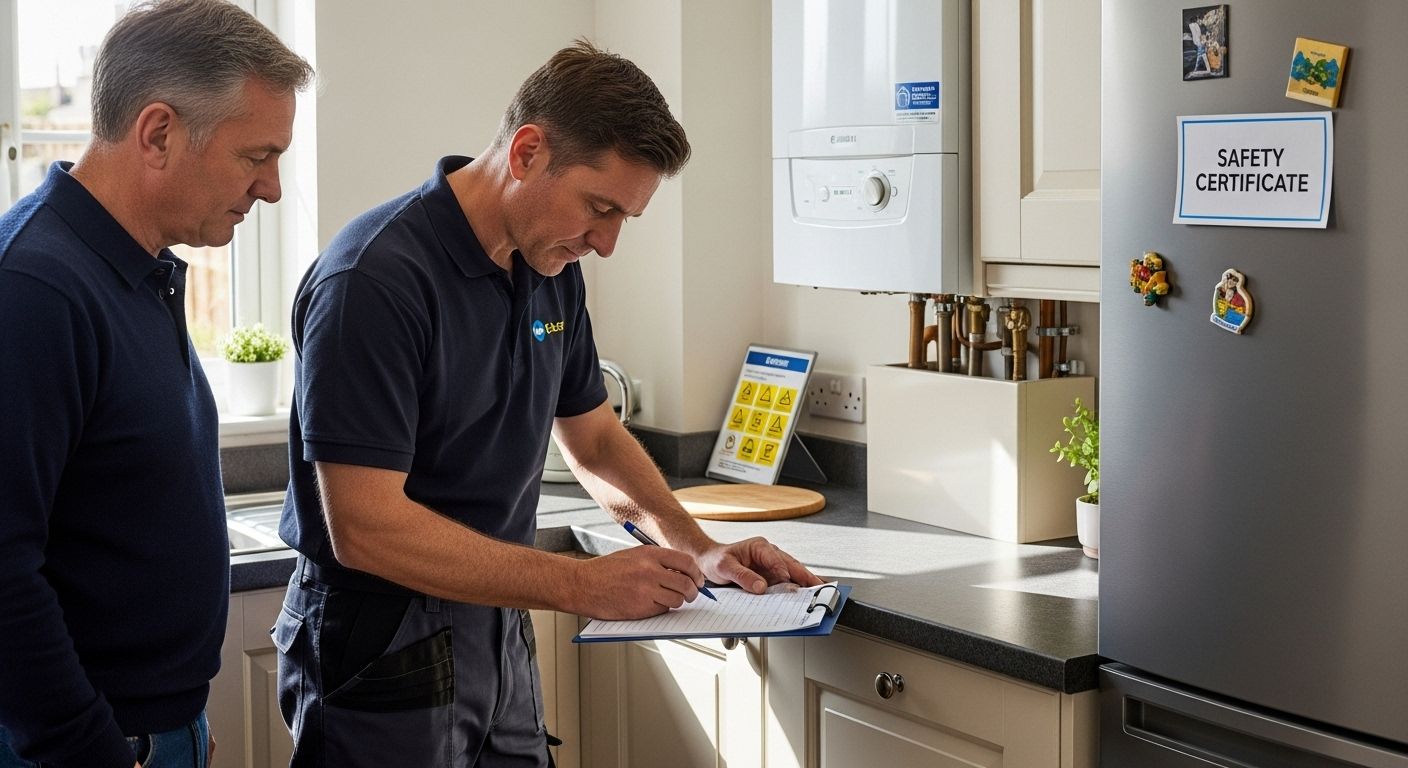
Understanding the Legal Obligations for Landlords
Landlord gas safety obligations represent a complex framework of legal responsibilities designed to protect tenant welfare and ensure safe living environments. These requirements extend far beyond simple administrative tasks, forming a critical component of residential property management that carries significant legal and ethical implications.
Statutory Compliance Requirements
Gas safety regulations create a comprehensive legal framework that landlords must navigate carefully. According to Health and Safety Executive, these obligations are not optional recommendations but mandatory legal requirements with serious consequences for non-compliance.
Key statutory compliance elements include:
- Annual gas safety inspections by registered engineers
- Maintaining detailed documentation of all safety checks
- Providing tenants with safety documentation within 28 days of inspection
- Ensuring all gas appliances meet current safety standards
- Promptly addressing any identified safety issues
Consequences of Non-Compliance
To help clarify the key legal and safety responsibilities of landlords regarding gas safety, the following table summarises the main statutory compliance requirements and the potential consequences of non-compliance as described in the article.
| Requirement / Consequence | Description |
|---|---|
| Annual Gas Safety Inspection | Landlords must arrange inspections by Gas Safe Registered engineers every year. |
| Inspection Record Keeping | Maintain detailed records of all gas safety checks for at least two years. |
| Providing Certificate to Tenants | Tenants must receive the gas safety certificate within 28 days of inspection. |
| Addressing Identified Issues | Prompt action must be taken to resolve any safety risks found during inspection. |
| Financial Penalties | Non-compliance can lead to substantial fines up to £20,000. |
| Legal Prosecution | Failure to comply may result in criminal prosecution or even imprisonment for landlords. |
| Insurance Invalidation | Property insurance may become void if gas safety obligations are not met. |
The legal landscape surrounding gas safety is unforgiving for landlords who fail to meet their responsibilities. Violations can trigger a cascade of severe legal and financial repercussions that extend well beyond simple administrative penalties.
Potential consequences encompass:
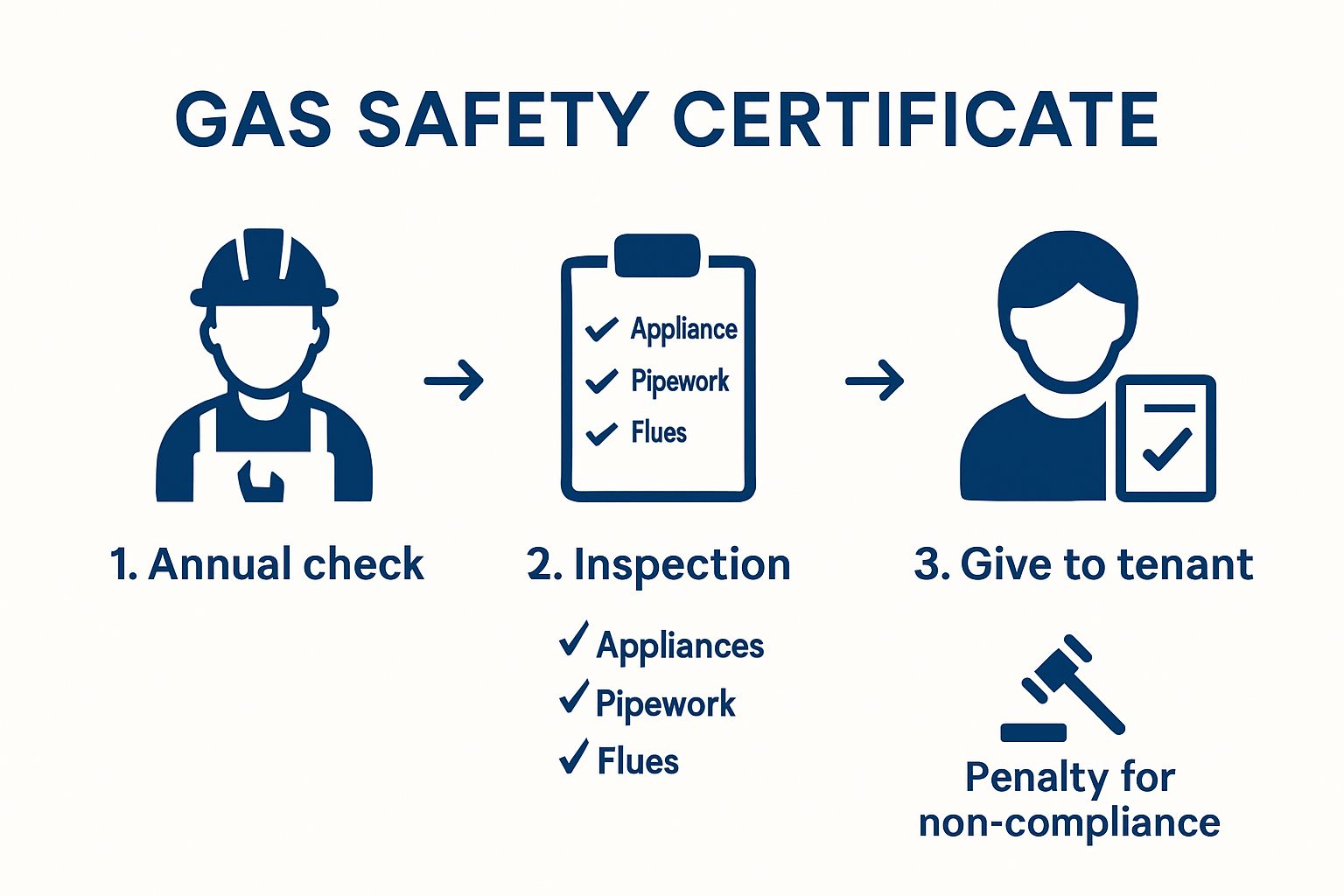
- Substantial financial penalties up to £20,000
- Potential criminal prosecution
- Invalidation of property insurance
- Potential imprisonment for serious breaches
- Automatic termination of tenancy agreements
These legal obligations represent more than bureaucratic requirements. They reflect a fundamental duty of care that landlords owe to their tenants, ensuring that rental properties provide safe, habitable living spaces free from potentially life-threatening gas-related risks. By understanding and proactively meeting these legal standards, landlords protect not just their tenants but also their own professional reputation and financial interests.
Protect Your Tenants and Property with Reliable Gas Safety Services
Worried about meeting your legal obligations as a landlord or need assurance that your gas appliances are truly safe? As discussed in this article, failing to secure a valid landlord gas safety certificate puts your tenants and property at risk and may lead to heavy fines or even severe legal consequences. You can avoid these dangers by choosing qualified engineers who understand the strict standards involved in gas safety.

Take the uncertainty out of compliance and safety. Work with Thermatek Heating, your trusted local team of Gas Safe Registered engineers serving Edinburgh and Midlothian. We specialise in comprehensive landlord gas safety inspections as well as expert boiler servicing and repairs and provide ongoing support to keep your property secure and tenants protected. Visit our main website now to request your free quote. Act now to ensure your property is always protected and up to standard.
Frequently Asked Questions
What is a landlord gas safety certificate?
A landlord gas safety certificate is an official document that verifies the safety of gas appliances and installations within a rental property. It confirms that all gas equipment has been professionally inspected and meets safety standards, ensuring protection for both tenants and property owners.
How often do landlords need to obtain a gas safety certificate?
Landlords are legally required to secure a gas safety certificate annually for every rental property that contains gas appliances. This yearly inspection is crucial for ensuring ongoing compliance with safety regulations.
What are the consequences of not having a valid gas safety certificate?
Failing to obtain a valid gas safety certificate can lead to significant legal repercussions for landlords, including hefty fines, potential imprisonment, and invalidation of property insurance. Non-compliance can also damage a landlord’s reputation and tenant trust.
What does a gas safety inspection involve?
A gas safety inspection involves a comprehensive evaluation of all gas appliances within the property. Qualified Gas Safe Registered engineers assess the condition of gas installations, check for leaks, measure gas pressure, and ensure proper ventilation and combustion processes to maintain safety standards.
Recommended
- New Boiler Installation & Replacement In Edinburgh - Thermatek Heating
- Landlord Gas Safety Certificates In Edinburgh - Thermatek Heating
- Annual Boiler Servicing In Edinburgh - Thermatek Heating
- Boiler Repair In Edinburgh | 24/7 Emergency Call Out - Thermatek Heating
Understanding How Does a Boiler Work for Heating
Boilers quietly power most homes and businesses, keeping water hot and spaces warm during those long British winters. Yet despite their importance, many people have no idea how these systems actually work. What might surprise you is that modern condensing boilers can reach efficiency ratings as high as 95 percent, far outshining older models and slashing energy waste. And while the technology may seem complex, understanding it could unlock untapped savings and safer, cosier living for everyone.
Table of Contents
- What Is A Boiler And Its Role In Heating Systems?
- Why Understanding Boiler Function Is Essential For Homeowners
- How Does A Boiler Work? Key Components And Their Functions
- The Importance Of Boiler Efficiency And Maintenance
- Renewable Energy Options In Boiler Technology
Quick Summary
| Takeaway | Explanation |
|---|---|
| Boilers provide efficient home heating | Modern boilers can achieve up to 95% efficiency, reducing energy bills significantly. |
| Regular maintenance extends boiler lifespan | Consistent inspection and upkeep can prevent costly repairs and ensure reliable heating performance. |
| Understanding boiler function aids energy savings | Knowledge of your boiler helps identify inefficiencies and implement effective energy-saving strategies. |
| Safety checks prevent hazardous issues | Regular inspections can prevent risks such as carbon monoxide leaks and system failures. |
| Explore renewable energy options for sustainability | Renewable technologies can reduce carbon emissions by up to 70%, making heating more eco-friendly. |
What is a Boiler and Its Role in Heating Systems?
A boiler is a sophisticated heating appliance designed to generate warmth and provide hot water for residential and commercial spaces. Unlike simple heating elements, boilers operate through a complex thermodynamic process that transforms water or other fluids into heated steam or hot water, which is then distributed throughout a building’s heating system.
Core Function of Boilers in Home Heating
At its fundamental level, a boiler works by heating water or generating steam using various energy sources such as gas, electricity, or oil. This heated medium then circulates through radiators, underfloor heating systems, or other heat distribution networks, effectively warming interior spaces. The mechanism allows for consistent and controlled temperature management, making boilers a critical component in modern heating infrastructure.
The primary roles of a boiler extend beyond mere temperature regulation. They serve multiple crucial functions:
- Generate heated water for domestic use
- Provide consistent central heating across multiple rooms
- Maintain comfortable indoor temperatures during cold seasons
- Offer energy-efficient heating solutions
To help readers quickly grasp the key roles and features of boilers within home heating systems, the following table summarises each function described in the article:
| Boiler Role or Feature | Description |
|---|---|
| Generate heated water for domestic use | Supplies hot water for taps, showers, and household needs |
| Provide central heating across rooms | Delivers consistent heat via radiators or underfloor systems |
| Maintain comfortable indoor temperatures | Ensures even, controllable warmth during cold seasons |
| Enable efficient energy use | High-efficiency models reduce energy consumption and utility costs |
| Support temperature management | Advanced controls regulate and optimise interior climate |
| Offer consistent heat distribution | Reliable operation prevents temperature fluctuations |
| Reduce carbon emissions | Modern boilers lower household environmental impact |
Heating Mechanism and Energy Conversion
Modern boilers exemplify remarkable energy conversion technologies. When fuel is combusted within the boiler’s chamber, it generates thermal energy that transfers to water or another heat transfer medium. This process involves precise temperature control mechanisms that ensure efficient heat distribution while minimizing energy waste.
According to Energy Saving Trust, the efficiency of a boiler can significantly impact household energy consumption, with modern condensing boilers achieving efficiency ratings up to 95%, representing a substantial improvement over older heating systems. This high efficiency translates into reduced energy bills and lower carbon emissions, making contemporary boilers not just heating devices but also environmentally conscious technologies.
Why Understanding Boiler Function is Essential for Homeowners
Comprehending how your boiler operates is far more than a technical exercise it represents a critical aspect of responsible home management. By developing a nuanced understanding of your heating system, homeowners can make informed decisions about maintenance, efficiency, and potential upgrades that directly impact comfort, energy consumption, and household expenses.
Financial and Energy Efficiency Implications
Boiler knowledge empowers homeowners to recognize potential inefficiencies and take proactive measures. Understanding the intricate mechanics of your heating system allows you to identify warning signs of reduced performance, potential energy waste, and opportunities for optimization. When you comprehend how heat generation and distribution work, you can:
- Implement targeted energy-saving strategies
- Recognize early signs of system deterioration
- Make informed decisions about repair versus replacement
- Anticipate potential maintenance requirements
Safety and Preventative Maintenance Considerations
Beyond financial considerations, understanding boiler function is crucial for ensuring household safety. Boilers involve complex interactions between fuel, combustion processes, and heat transfer mechanisms that, if not properly maintained, can pose significant risks. Gas Safe Register emphasizes that regular professional inspections and a basic understanding of your system can prevent potential hazards such as carbon monoxide leaks, system failures, and unexpected breakdowns.
For homeowners seeking more in-depth guidance, our comprehensive guide on boiler replacement offers valuable insights into maintaining and upgrading your home heating infrastructure. Knowing when and how to upgrade your system can lead to substantial long-term benefits in performance, safety, and energy efficiency.
How Does a Boiler Work? Key Components and Their Functions
A boiler operates as a sophisticated thermal energy conversion system, transforming fuel energy into heat through a precisely engineered process. The intricate mechanism involves multiple interconnected components working harmoniously to generate and distribute warmth throughout a building.
Core Operational Mechanism
At the heart of boiler functionality is a complex heat transfer process. When fuel combusts within the boiler’s combustion chamber, it generates intense thermal energy. This heat is transferred to water or another heat transfer medium, typically through a network of pipes and heat exchangers. The heated fluid then circulates through radiators or underfloor heating systems, effectively distributing warmth across interior spaces.
The primary components essential to this process include:
- Combustion chamber where fuel burns
- Heat exchanger for thermal energy transfer
- Circulating pump to move heated water
- Temperature and pressure control mechanisms
- Flue system for exhaust gas evacuation
Technical Components and Energy Transformation
Each boiler component plays a critical role in energy conversion and heat distribution. The combustion chamber generates high temperatures through controlled fuel burning, while the heat exchanger efficiently transfers thermal energy to the water. Circulating pumps ensure consistent fluid movement, maintaining a steady heat supply throughout the heating system.
According to Energy Saving Trust, modern boilers achieve remarkable energy efficiency by optimizing these component interactions. The precision engineering allows for minimal heat loss and maximum thermal output, representing a significant advancement in home heating technologies.
For homeowners seeking comprehensive insights into heating system upgrades, understanding these technical mechanisms provides valuable context for making informed decisions about home heating infrastructure.
The Importance of Boiler Efficiency and Maintenance
Boiler efficiency and regular maintenance are critical factors that directly influence a home’s energy consumption, operational costs, and overall heating system performance. Understanding and implementing strategic maintenance practices can significantly extend equipment lifespan, reduce energy expenditure, and ensure consistent, reliable heating throughout your property.
Economic and Performance Implications
The relationship between maintenance and boiler efficiency is profound and multifaceted. A well-maintained boiler operates at peak performance, consuming less energy while delivering optimal heat distribution. Neglecting routine maintenance can lead to gradual performance degradation, increased energy consumption, and potentially expensive repair or replacement scenarios.
Key economic considerations include:
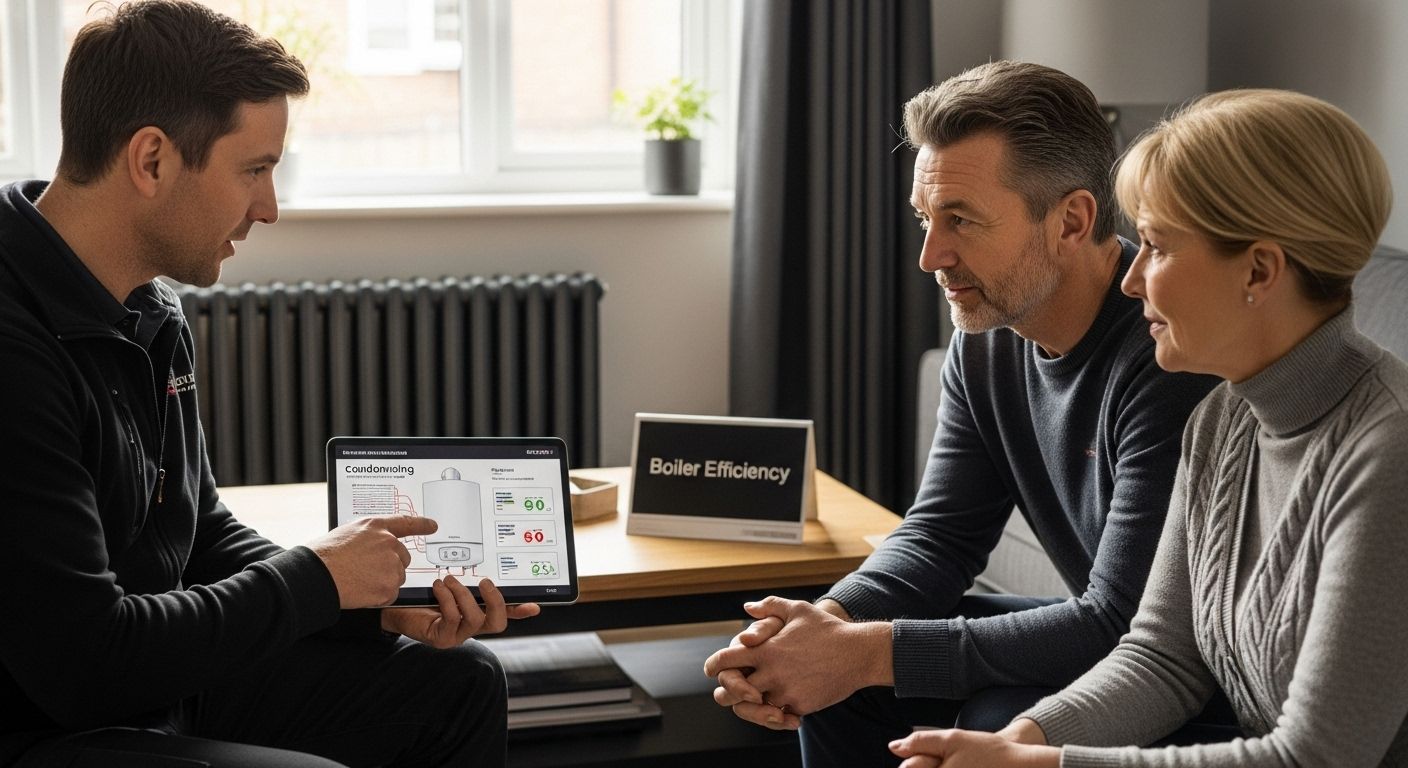
- Potential energy cost savings of up to 15% through regular maintenance
- Reduced risk of unexpected system failures
- Extended equipment operational lifespan
- Improved overall heating system reliability
Technical Maintenance and Efficiency Strategies
Effective boiler maintenance involves a comprehensive approach that addresses multiple technical aspects. This includes regular cleaning of heat exchangers, checking and replacing worn components, ensuring proper combustion settings, and verifying system pressure and temperature calibrations. Professional inspections can identify potential issues before they escalate into major problems.
According to the National Institute of Standards and Technology, systematic maintenance is crucial for maintaining high system efficiency and preventing performance deterioration. For homeowners seeking expert guidance on comprehensive boiler care, professional assessment can provide tailored recommendations that maximize heating system performance and longevity.
Renewable Energy Options in Boiler Technology
Renewable energy technologies are transforming traditional boiler systems, offering innovative solutions that reduce carbon emissions, enhance energy efficiency, and provide sustainable heating alternatives for modern homes and businesses. These emerging technologies represent a significant shift towards environmentally conscious heating infrastructure.
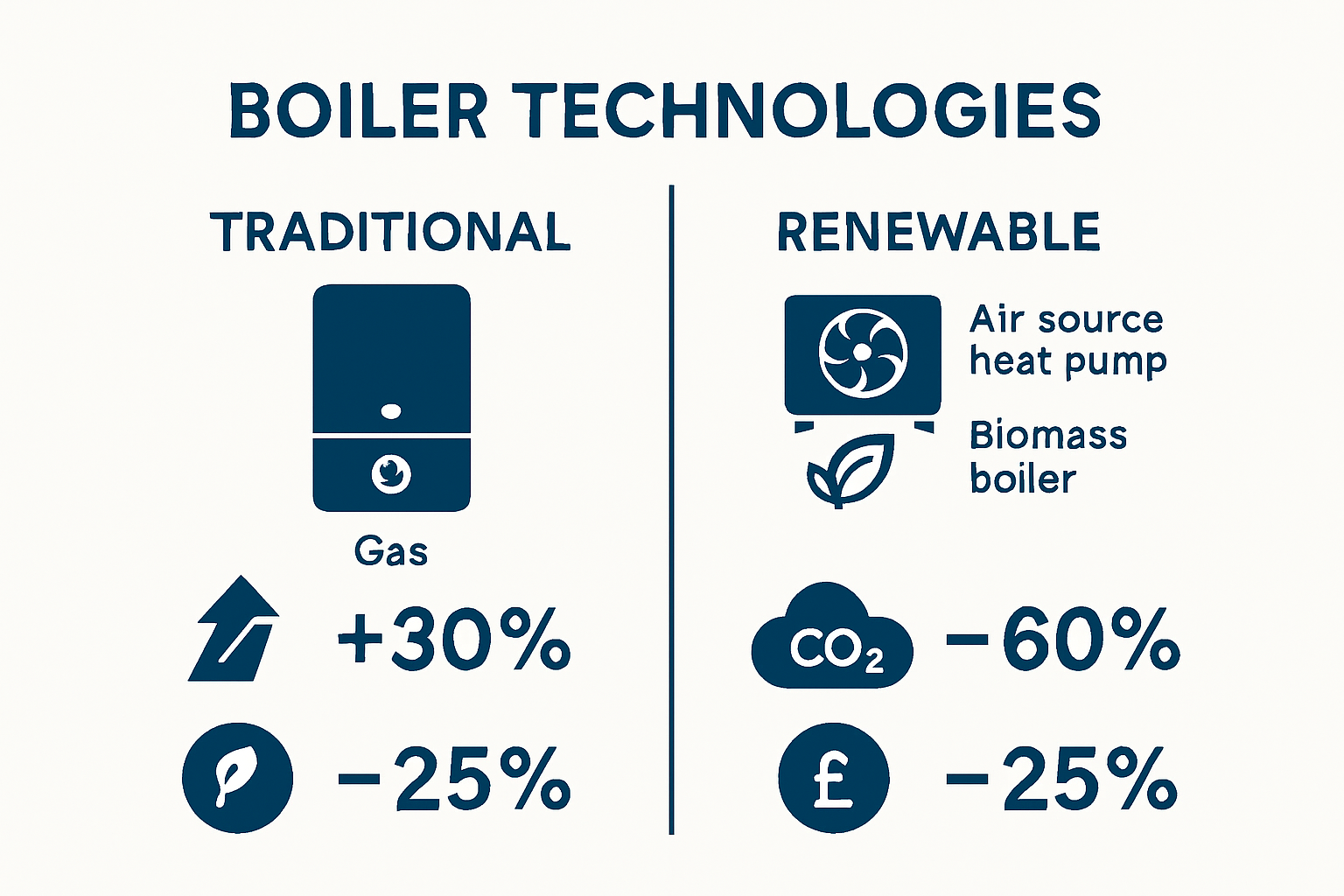
Emerging Renewable Heating Technologies
Modern renewable boiler technologies integrate advanced energy sources that minimise environmental impact while maintaining high performance standards. These systems leverage alternative energy generation methods to produce heat, moving beyond conventional fossil fuel dependencies. The most prominent renewable technologies currently revolutionising boiler design include:
- Air source heat pumps extracting thermal energy from ambient air
- Ground source heat pumps utilising geothermal underground temperatures
- Solar thermal systems capturing solar radiation for water heating
- Biomass boilers using organic materials as sustainable fuel sources
- Hybrid systems combining multiple renewable energy technologies
Performance and Environmental Benefits
Renewable boiler technologies offer substantial advantages beyond traditional heating systems. They provide more stable energy generation, significantly reduced carbon footprints, and often lower long-term operational costs. The ability to generate heat from naturally replenishing sources represents a fundamental transformation in home and commercial heating strategies.
According to the Energy Saving Trust, renewable heating technologies can reduce household carbon emissions by up to 70% compared to conventional gas boilers. For homeowners interested in exploring sustainable heating upgrades, these innovative solutions offer a promising pathway towards more environmentally responsible energy consumption.
Make Your Boiler Work Smarter – Trust Thermatek for Reliable Heating
Understanding how boilers work helps you spot problems early, stay safe, and avoid rising energy bills. If you are concerned about efficiency, unexpected breakdowns, or simply want to upgrade to modern, energy-saving solutions, you deserve professional support you can trust. With so much depending on your boiler’s performance, it is not worth risking comfort or safety. Let the experts ensure your heating is working its best.

Ready to take control of your home’s heating? Discover how our Gas Safe Registered engineers can help with boiler replacement, maintenance, or renewable energy options. Visit Thermatek Heating for a free quote and see why so many Edinburgh and Midlothian homeowners rely on us for safe, efficient, and cost-effective heating. If you are thinking about a replacement or upgrade, get more details on our boiler replacement services and explore our work with renewable energy solutions. Act now to stay comfortable and protect your investment.
Frequently Asked Questions
What are the main components of a boiler?
The main components of a boiler include the combustion chamber, heat exchanger, circulating pump, temperature and pressure control mechanisms, and the flue system for exhaust gas evacuation.
How does a boiler generate heat for my home?
A boiler generates heat by combusting fuel in the combustion chamber, which produces thermal energy. This heat is then transferred to water or another medium via the heat exchanger, allowing it to circulate through radiators or underfloor heating systems to warm the living spaces.
Why is boiler efficiency important for homeowners?
Boiler efficiency is crucial as it directly affects energy consumption and heating costs. A more efficient boiler operates using less fuel to produce the same amount of heat, leading to lower energy bills and reduced carbon emissions.
How can I maintain my boiler for optimal performance?
Regular maintenance of a boiler includes cleaning heat exchangers, checking and replacing worn components, verifying combustion settings, and ensuring proper system pressure and temperature. Professional inspections can help identify potential issues before they escalate.
Recommended
- New Boiler Installation & Replacement In Edinburgh - Thermatek Heating
- Boiler Repair In Edinburgh | 24/7 Emergency Call Out - Thermatek Heating
- Annual Boiler Servicing In Edinburgh - Thermatek Heating
Choosing a New Boiler: A Guide for Edinburgh and Midlothian
Choosing a new boiler in Edinburgh or Midlothian is not just a technical upgrade. Most people think it all comes down to the brand or a quick installation, but that barely scratches the surface. The real impact? Modern condensing boilers now reach up to 95 percent efficiency, which can slash your energy bills year after year. That single choice reshapes comfort and cost for your whole home, and deciding without the full picture can mean missing out on serious savings.
Table of Contents
- Key Factors When Choosing A New Boiler
- Best Boilers For Homes, Rentals And Businesses
- Energy Efficiency And Future-Proof Heating Options
- Local Support And Installation Services In Edinburgh
Quick Summary
| Takeaway | Explanation |
|---|---|
| Assess your home’s heating needs first | Evaluate factors like size, insulation, and hot water demand to select the right boiler type. |
| Choose high-efficiency boilers for savings | Modern condensing boilers can achieve up to 95% efficiency, reducing long-term energy costs significantly. |
| Consider fuel type for compatibility | Natural gas is common but assess oil or renewables if gas isn’t available for your property. |
| Select the right boiler type for your property | Combi boilers are ideal for homes, while system boilers suit larger or rental properties with more hot water needs. |
| Seek local installation and maintenance support | Use local professionals for tailored advice and ongoing maintenance based on Edinburgh’s unique conditions. |
Key Factors When Choosing a New Boiler
Choosing a new boiler represents a significant investment for homeowners in Edinburgh and Midlothian. The decision involves multiple critical considerations that go far beyond simple price comparisons. Your selection will impact your home’s comfort, energy efficiency, and long term running costs.
Understanding Your Home’s Heating Requirements
Before selecting a new boiler, a comprehensive assessment of your property’s specific heating needs is crucial. The size of your home, number of radiators, hot water demand, and existing heating infrastructure all play pivotal roles in determining the most suitable boiler type. Our guide on heating system assessments can help homeowners understand these intricate details.
According to Energy Saving Trust, the wrong boiler size can lead to significant energy wastage. An oversized boiler will consume more energy than necessary, while an undersized unit will struggle to meet your heating demands. Professional heating engineers typically calculate your requirements using detailed heat loss calculations that consider factors like:
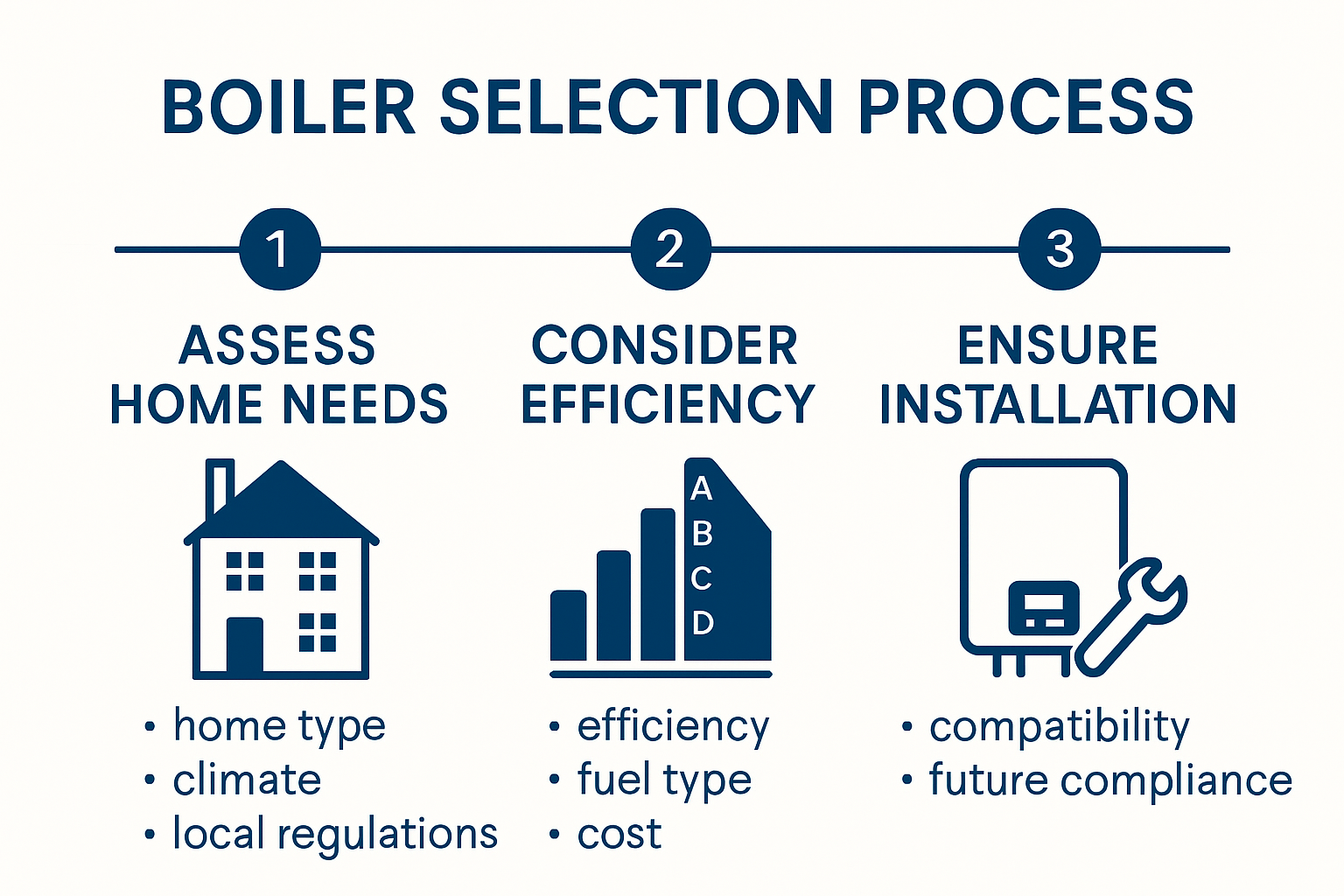
- Property insulation levels
- Total floor area
- Number of occupants
- Hot water usage patterns
Efficiency and Running Costs
Modern boilers are significantly more energy efficient compared to older models. The latest condensing boilers can achieve efficiency ratings up to 95%, translating into substantial energy bill reductions. Which? Magazine recommends focusing on the Annual Fuel Utilisation Efficiency (AFUE) rating when comparing different models.
Key efficiency considerations include:
- Condensing technology
- Smart heating controls
- Modulation capabilities
- Energy rating certifications
While high efficiency models might have a higher upfront cost, the long term savings on energy bills can be substantial. Homeowners can expect to recoup their initial investment through reduced heating expenses within several years.
Fuel Type and Installation Compatibility
The fuel type available in your property significantly influences boiler selection. Most homes in the region use either natural gas, oil, or are transitioning to renewable energy solutions. Each fuel type has distinct advantages and installation requirements.
Natural gas remains the most common and typically most cost effective option. However, properties without gas connections might need to consider alternative solutions like oil fired boilers or emerging renewable technologies such as air source heat pumps.
Professional assessment ensures your chosen boiler integrates seamlessly with existing pipework, radiator systems, and meets current building regulations. Expert installation is critical to maximising system performance and longevity.
Best Boilers for Homes, Rentals and Businesses
Selecting the right boiler requires understanding the unique heating demands of different property types. From compact residential spaces to expansive commercial properties, each environment demands a tailored heating solution that balances efficiency, reliability, and cost effectiveness.
To help Edinburgh and Midlothian homeowners compare boiler options, here’s a summary table outlining key differences between combi, system, and commercial boilers as described in the article.
| Boiler Type | Typical Use | Key Advantages | Hot Water Supply |
|---|---|---|---|
| Combi Boiler | Residential homes | Space-saving, instant hot water, lower installation costs | No separate cylinder required |
| System Boiler | Larger/rental properties | Robust performance, serves multiple bathrooms, low maintenance | Requires separate hot water tank |
| Commercial Boiler | Businesses, large sites | Zoned heating, advanced controls, high efficiency, scalability | Large-scale, modular supply |
Residential Boiler Solutions
For homeowners in Edinburgh and Midlothian, combi boilers represent an increasingly popular choice. Learn more about our residential heating solutions to understand the nuanced requirements of home heating systems.
According to Which? Trusted Traders, combi boilers offer several advantages for residential properties:
- Space efficiency: Compact design ideal for smaller homes
- Instant hot water: No separate cylinder required
- Lower installation costs
- High energy efficiency ratings
Residential properties typically require boilers between 24kW and 35kW, depending on home size and hot water demand. Factors like insulation quality, number of bathrooms, and total radiator count significantly influence the optimal boiler selection.
Rental Property Heating Requirements
Landlords face unique challenges when selecting boilers for rental properties. Durability, maintenance simplicity, and consistent performance become paramount considerations. Energy Performance Certificates now play a crucial role in rental property assessments, making energy efficient boilers increasingly important.
The Residential Landlords Association recommends system boilers for rental properties due to their:
- Robust performance
- Compatibility with larger properties
- Ability to serve multiple bathrooms
- Lower maintenance requirements
System boilers store hot water in a separate cylinder, providing consistent supply for properties with higher simultaneous hot water demands. This makes them particularly suitable for shared accommodations or larger rental units.
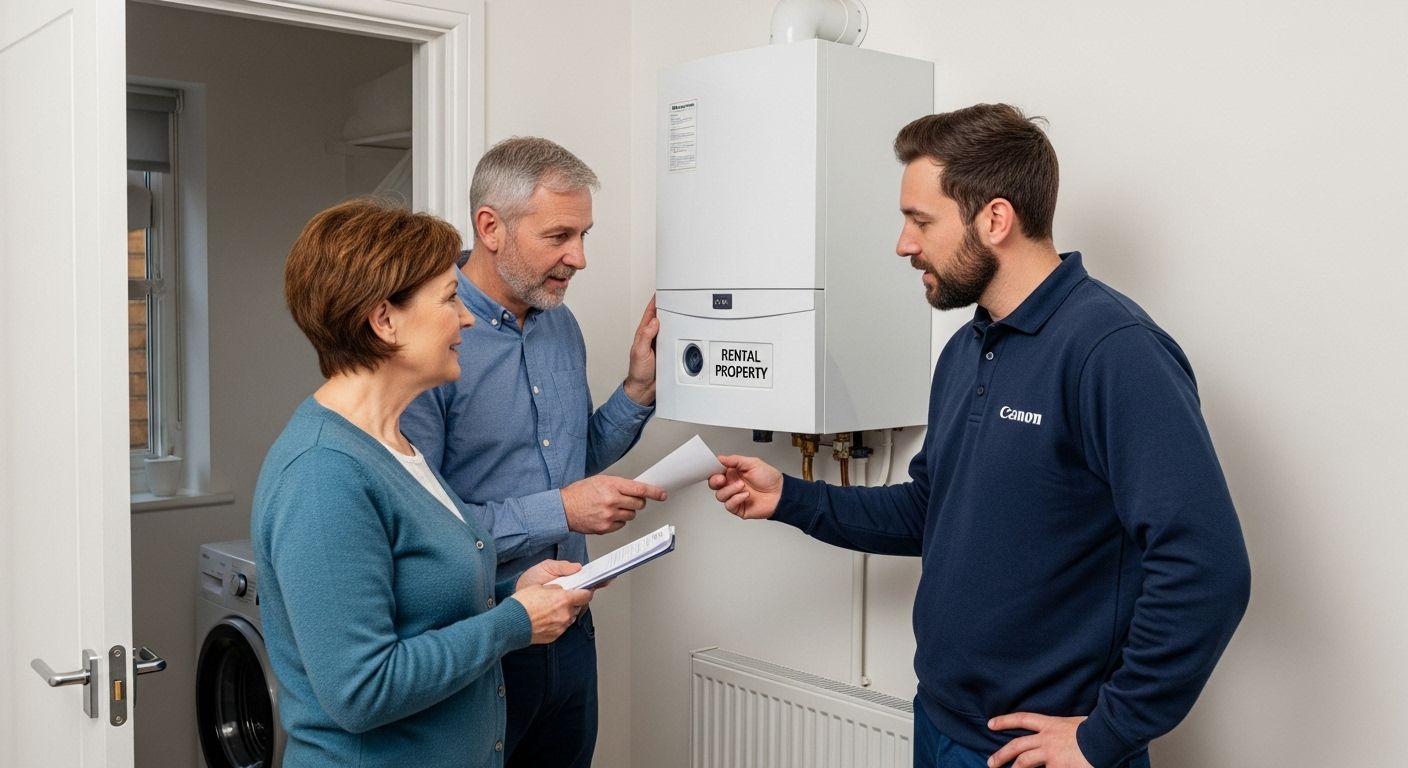
Commercial and Business Heating Solutions
Commercial properties require substantially different heating approaches compared to residential settings. Industrial and commercial boilers must handle significantly higher heat loads, accommodate complex heating zones, and provide consistent performance under demanding conditions.
Commercial properties typically utilise condensing boiler technology with modular designs allowing scalable heating solutions. These systems can range from 50kW to over 1000kW, depending on specific business requirements. Key considerations include:
- Zoned heating capabilities
- High efficiency ratings
- Advanced control systems
- Redundancy and failsafe mechanisms
Professional assessment remains critical. Each commercial property presents unique thermal dynamics that demand expert evaluation to determine the most appropriate heating infrastructure.
Energy Efficiency and Future-Proof Heating Options
As global energy landscapes transform and environmental regulations become increasingly stringent, homeowners and businesses must consider heating solutions that not only meet current needs but anticipate future technological and regulatory changes. Explore our sustainable heating options to understand the cutting edge of heating technology.
Smart Technology and Energy Management
Modern heating systems are no longer simple heat generators but sophisticated networked technologies. According to the National Renewable Energy Laboratory, emerging heating technologies integrate advanced sensors, machine learning algorithms, and real time energy management capabilities.
Key smart technology features include:
- Adaptive temperature control
- Remote monitoring capabilities
- Predictive maintenance alerts
- Energy consumption analytics
These intelligent systems can reduce energy consumption by up to 30% compared to traditional heating infrastructure, providing significant long term cost savings and environmental benefits.
The following table summarises the main smart technology features highlighted for modern heating systems and their respective benefits, aiding readers in quickly identifying the value of these advancements.
| Smart Technology Feature | Benefit |
|---|---|
| Adaptive temperature control | Increased comfort and efficiency |
| Remote monitoring | Enables off-site system oversight |
| Predictive maintenance alerts | Prevents unexpected breakdowns, reduces costs |
| Energy consumption analytics | Tracks usage and identifies saving opportunities |
Renewable Energy Integration
The transition towards renewable energy sources represents a critical strategy for future proofing heating systems. Air source heat pumps, solar thermal technologies, and hybrid heating solutions are becoming increasingly viable alternatives to traditional gas boilers.
According to Energy Saving Trust, renewable technologies offer multiple advantages:
- Reduced carbon emissions
- Lower long term operating costs
- Government incentive eligibility
- Enhanced energy independence
Hybrid systems that combine traditional boilers with renewable technologies provide flexible, efficient heating solutions adaptable to changing energy infrastructures.
Regulatory Compliance and Future Standards
Building regulations and energy efficiency standards are continuously evolving. Properties with forward thinking heating solutions will be better positioned to meet upcoming environmental requirements. The UK government has set ambitious targets for reducing carbon emissions, which directly impacts heating technology development.
Key regulatory considerations include:
- Minimum energy efficiency standards
- Carbon emission reduction targets
- Renewable energy integration mandates
- Smart technology implementation guidelines
Investing in adaptable, high efficiency heating systems now can prevent costly retrofitting and ensure compliance with future regulatory frameworks. Professional assessment remains crucial in navigating these complex technological and regulatory landscapes.
Local Support and Installation Services in Edinburgh
Edinburgh and Midlothian residents require comprehensive local heating support that goes beyond simple product installation. Professional services that combine technical expertise, local knowledge, and customer focused approaches are essential for successful boiler replacements and maintenance. Discover our comprehensive local heating solutions tailored specifically for Edinburgh properties.
Professional Installation and Technical Expertise
Local heating support in Edinburgh demands a nuanced understanding of the region’s unique architectural diversity and environmental conditions. According to Public Contracts Scotland, housing associations and local authorities consistently prioritise high quality, energy efficient boiler installations that meet specific regional requirements.
Professional installation services in Edinburgh typically encompass:
- Comprehensive property assessment
- Custom heating system design
- Precision equipment selection
- Seamless integration with existing infrastructure
Qualified Gas Safe Registered engineers bring critical technical knowledge, ensuring installations comply with stringent Scottish building regulations and safety standards. Their expertise prevents common installation errors that could compromise system performance and property safety.
Local Regulatory Compliance and Support
The City of Edinburgh Council plays a significant role in maintaining high standards for heating infrastructure. Recent municipal contracts demonstrate a commitment to upgrading domestic heating systems, focusing on energy efficiency and sustainable technologies.
Key local support aspects include:
- Adherence to Scottish building regulations
- Energy performance certification
- Renewable energy transition support
- Financial guidance for heating upgrades
Local support services help homeowners navigate complex regulatory landscapes, offering guidance on potential grants, energy efficiency programmes, and sustainable heating technologies specific to Edinburgh’s urban and suburban environments.
Maintenance and Long Term Service Commitment
Beyond initial installation, reputable local heating services provide comprehensive maintenance programmes. The University of Edinburgh’s ongoing boiler maintenance contracts illustrate the importance of consistent, professional equipment upkeep.
Comprehensive maintenance services typically include:
- Annual safety inspections
- Performance optimization
- Predictive maintenance tracking
- Emergency repair support
Local providers understand Edinburgh’s specific environmental challenges, from historic building structures to variable climate conditions. This localised expertise ensures heating systems remain efficient, safe, and optimally configured throughout their operational lifecycle.
Choosing a local heating service with deep regional understanding provides homeowners with a significant advantage. The combination of technical expertise, regulatory knowledge, and community connection ensures a heating solution that is not just installed, but genuinely integrated into your property’s unique requirements.
Frequently Asked Questions
What factors should I consider when choosing a new boiler?
When selecting a new boiler, consider your home’s heating requirements, efficiency ratings, fuel type compatibility, and boiler type suitable for your property size. Assessing insulation levels, floor area, and hot water demand are also essential.
How do I determine the right boiler size for my home?
The correct boiler size is determined by evaluating factors like total floor area, property insulation, hot water usage patterns, and the number of occupants. Professional heat loss calculations can assist in identifying the ideal boiler capacity.
What are the benefits of high-efficiency boilers?
High-efficiency boilers, particularly modern condensing models, can reach efficiency ratings of up to 95%. This leads to significant savings on energy bills over time, providing a better return on investment despite a potentially higher initial cost.
How do renewable energy solutions influence boiler selection?
Renewable energy options, such as air source heat pumps and hybrid systems, are increasingly viable alternatives to traditional gas boilers. They offer lower operating costs, reduced carbon emissions, and eligibility for government incentives, making them an attractive long-term choice.
Ready to Transform Your Edinburgh Home’s Heating?
Choosing a new boiler is never just about the brand or the price. As highlighted in our guide, the real challenge lies in finding a heating solution that matches your property’s specific needs. Homeowners in Edinburgh and Midlothian often struggle with outdated systems, unpredictable costs, and compliance worries. If you are concerned about energy efficiency, future regulations, or making sure your new boiler is a perfect fit for your home, you need more than generic solutions. That is where our local knowledge and Gas Safe Registered engineers come in. Discover how our personalised assessments and smart heating installations can give you both peace of mind and lasting savings by exploring our boiler replacement service.

Don’t leave comfort and compliance to chance. Act now for a professional evaluation of your heating needs and unlock long-term efficiency with Thermatek. Visit thermatekheating.co.uk today to book your free quote or talk to our friendly team about the best energy-saving options for your property.
Recommended
- New Boiler Installation & Replacement In Edinburgh - Thermatek Heating
- Boiler Repair In Edinburgh | 24/7 Emergency Call Out - Thermatek Heating
- Annual Boiler Servicing In Edinburgh - Thermatek Heating
- Central Heating Power Flushing In Edinburgh - Thermatek Heating

